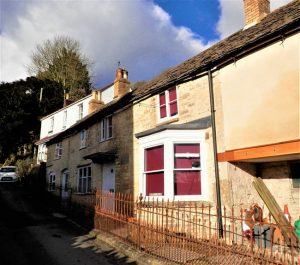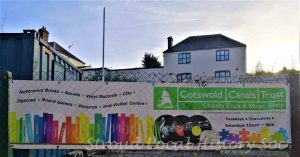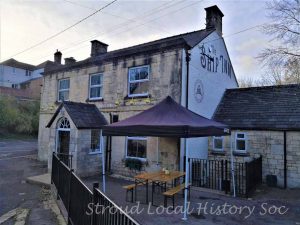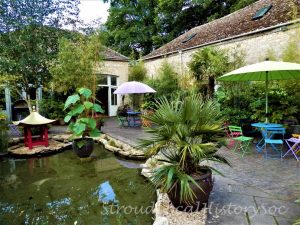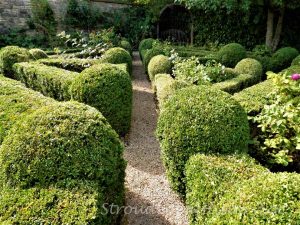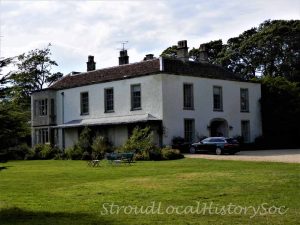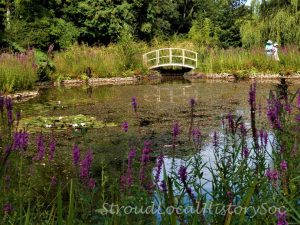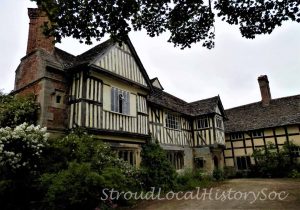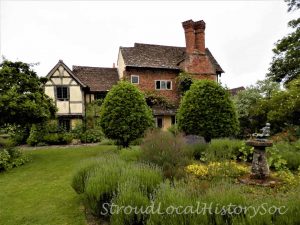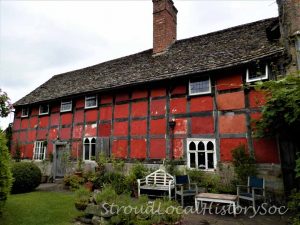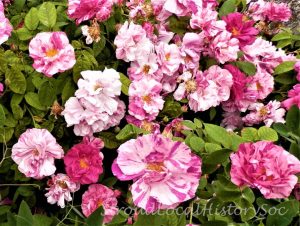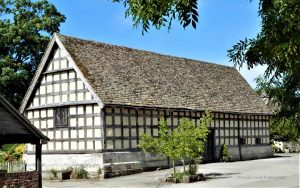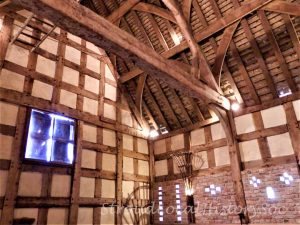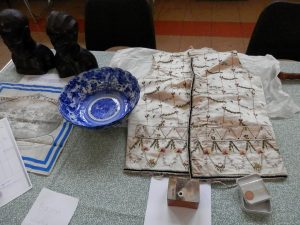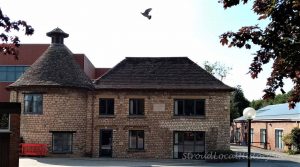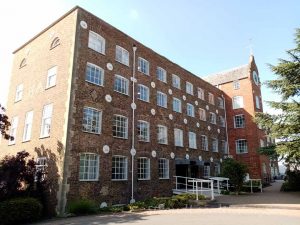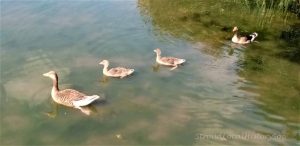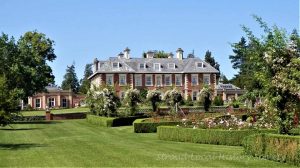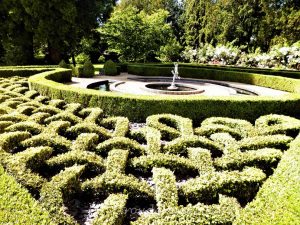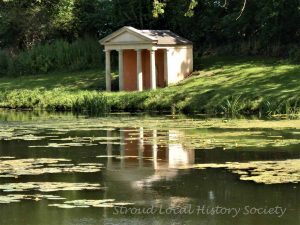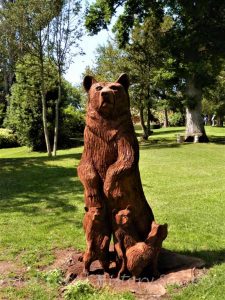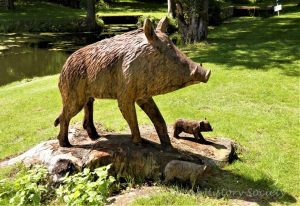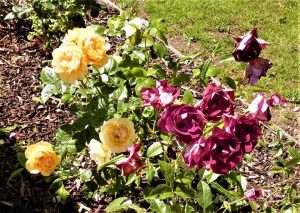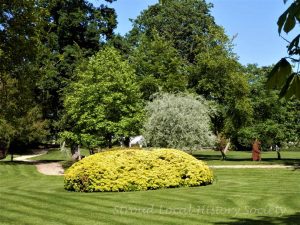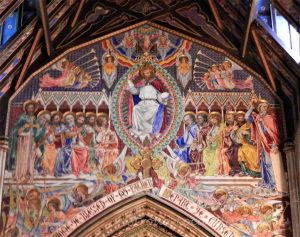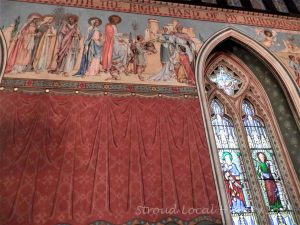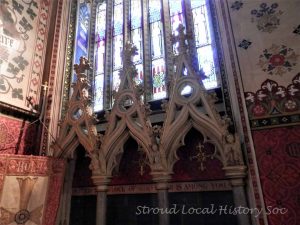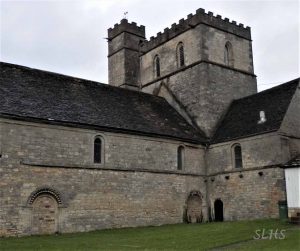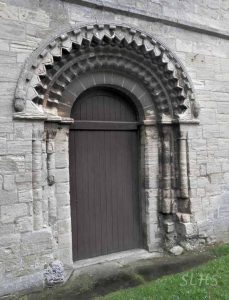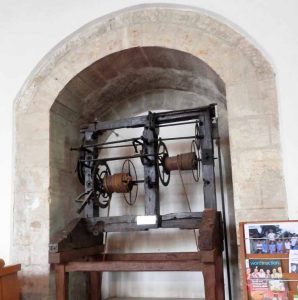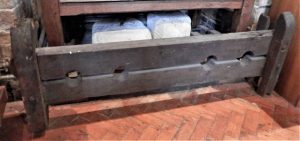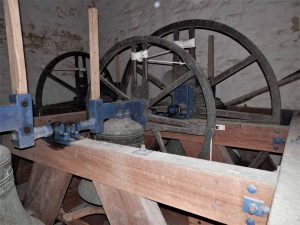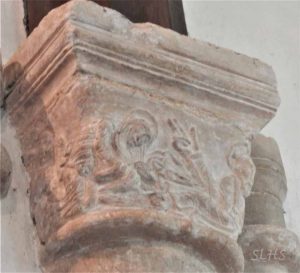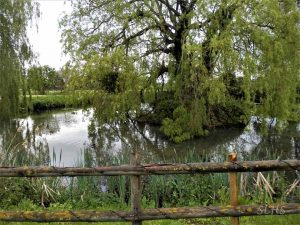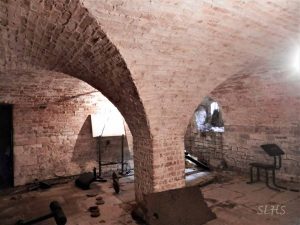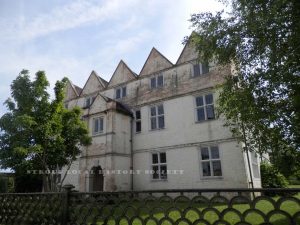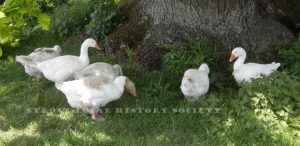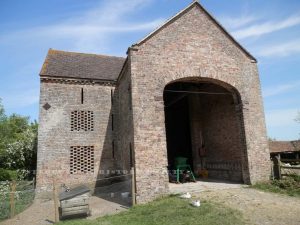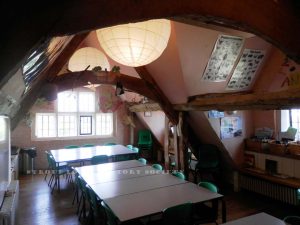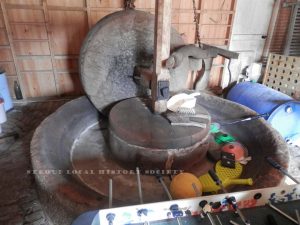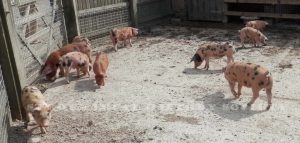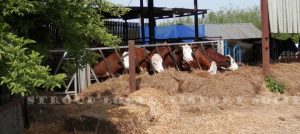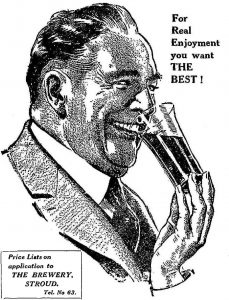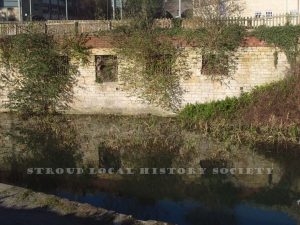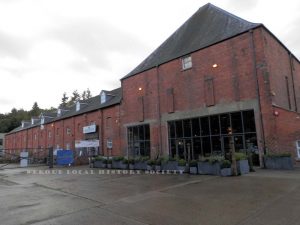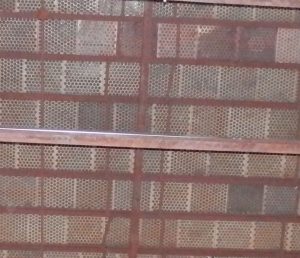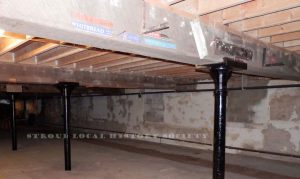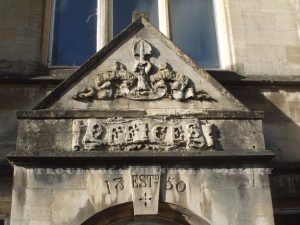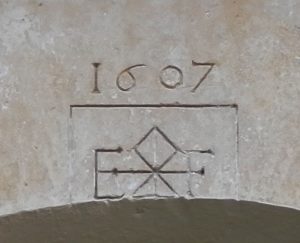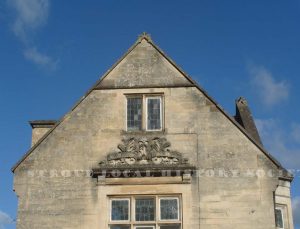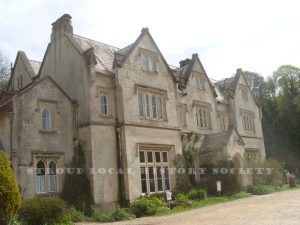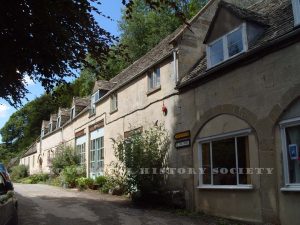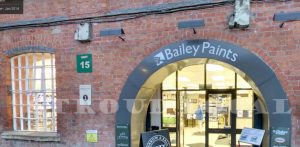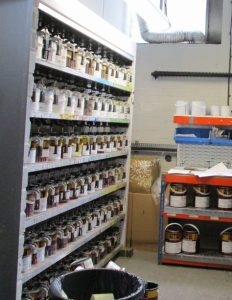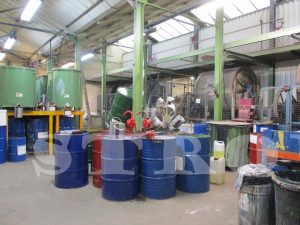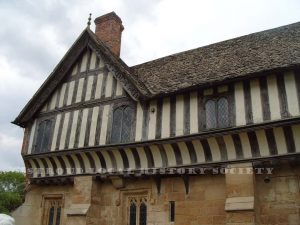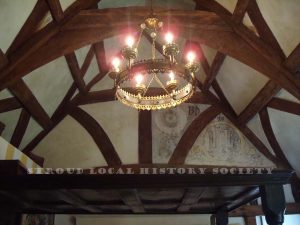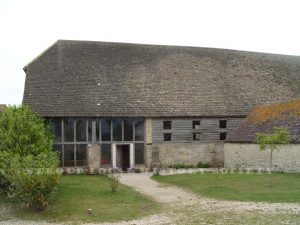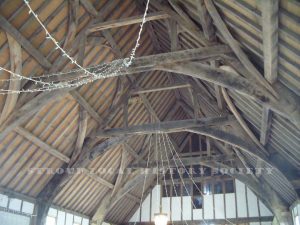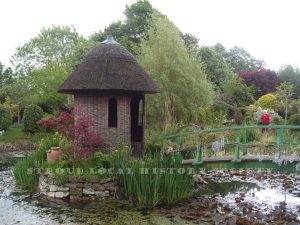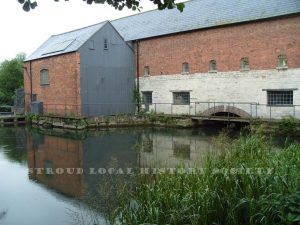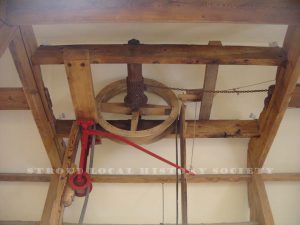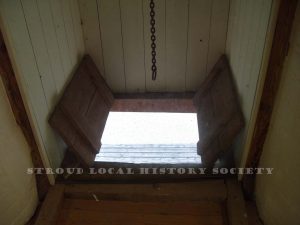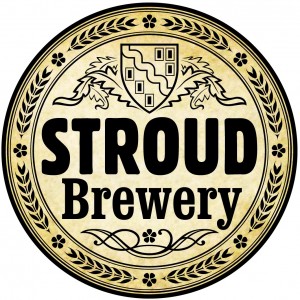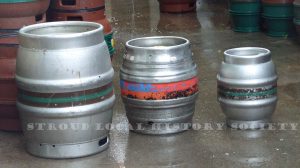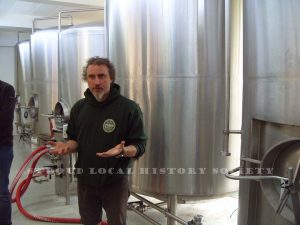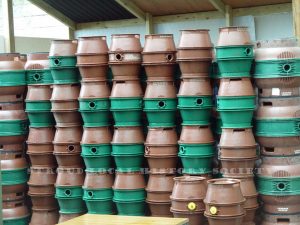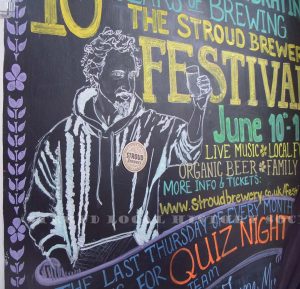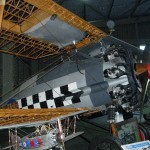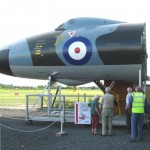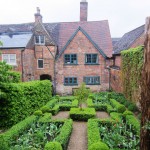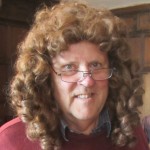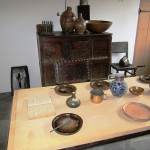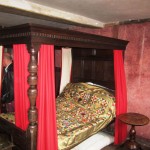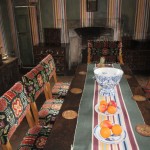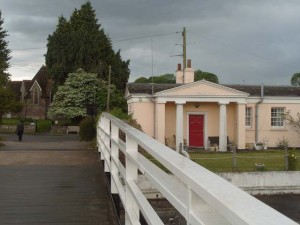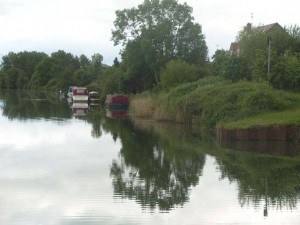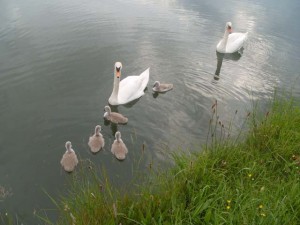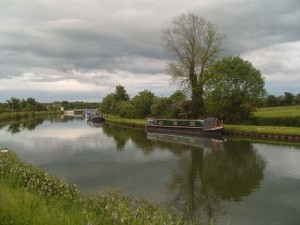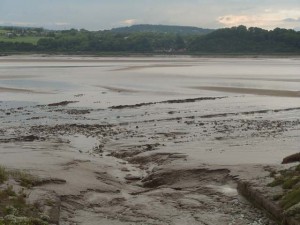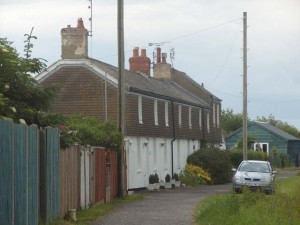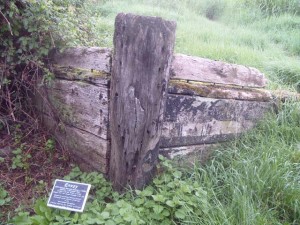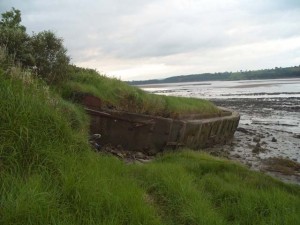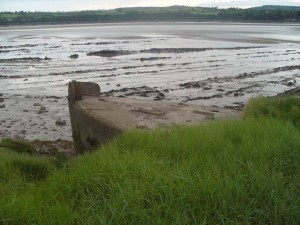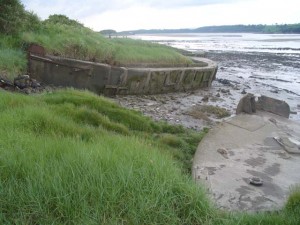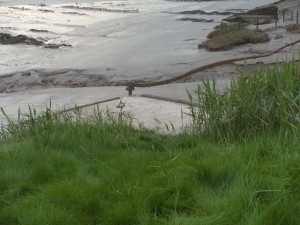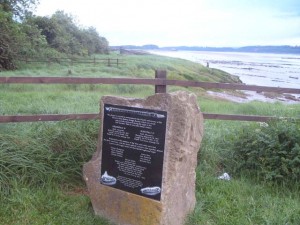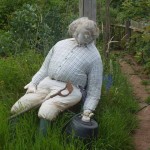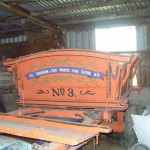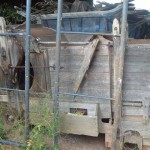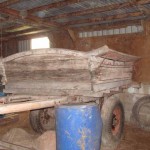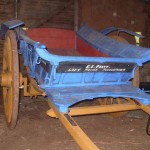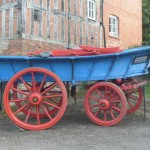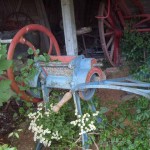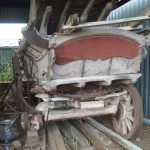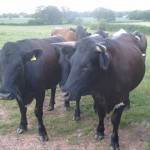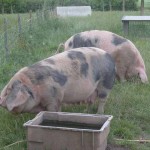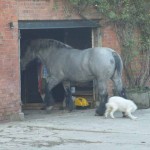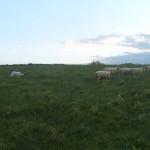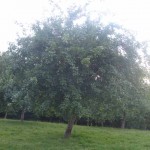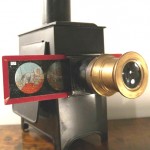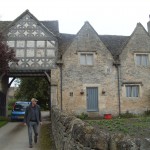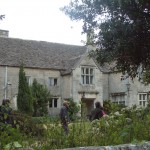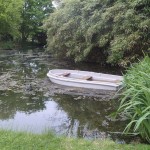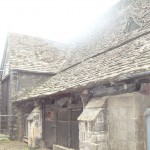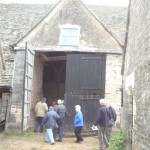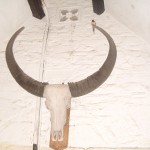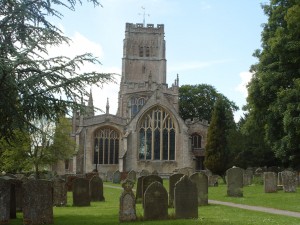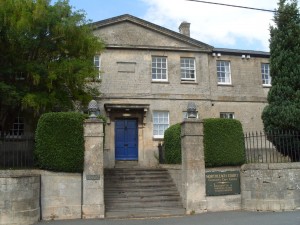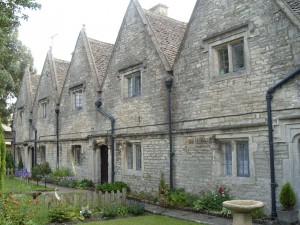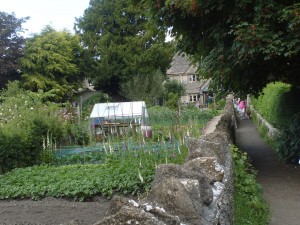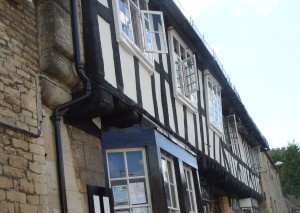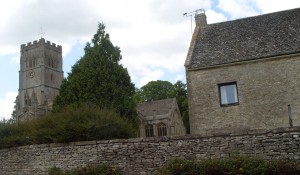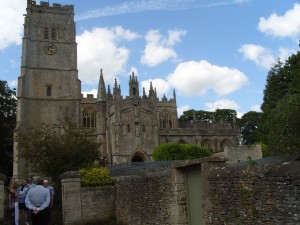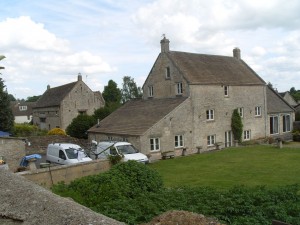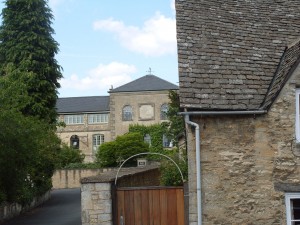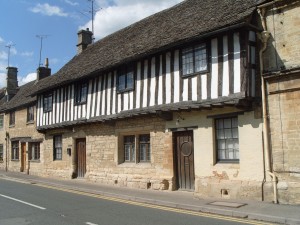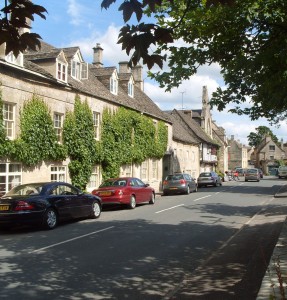2025 meetings & visits
15th May 2025: Murder at the Red Door – the story of Stroud’s Murder at Lodgemore by Martyn Beaufort
Described by the Stroud Journal as “one the foulest in the records of the county” the murder of Henry Allen, a 14-year-old lad, in Lodgemore Lane was the subject of this talk. Martyn apologised in advance for “all the gory details” that needed to be shared – and it was indeed gory. This young lad was sent regularly by his employer to collect the wages for Lightpill Mills and a local man, Edwin Pritchard, decided to befriend young Henry then steal the money. On New Year’s Eve 1886, he attacked Henry, who died of his wounds in Stroud Hospital. Pritchard was such an incompetent villain that he had left clues all round town. He was soon arrested, tried, and hanged in Gloucester prison on 17th February 1887. Lodgemore Lane was offical called Murder Lane until the mid-1960s.
10th April 2025: ‘Funeral Trains’ by Nicolas Wheatley
Nicholas, who spent some of his childhood in Stroud, talked to us about funeral trains, based on his book, ‘The Untold Story of Funeral Trains’ and a forthcoming work on royal funeral trains. From the 1840s until recently, the coffins of people who died away from where they were to be buried were transported, with dignity, by train, to their final resting place. Some railway lines had dedicated carriages for this, others, including GWR, deployed mail coaches. Many people were transported to the huge Brookwood Cemetery in Surrey which had its own ceremonial funeral train running from the Necropolis Station at Waterloo into the different sections of the cemetery. Royalty, and other important people, took the first part of their funeral journey on an ordinary train but were then placed on a ceremonial train decorated with wreaths and insignia. The charismatic priest Arthur Henry Stanton, who came from Stroud but ministered in London, took such a journey in 1913, with huge crowds lining the route between Paddington and Waterloo. Nicholas’s talk opened our eyes in a most fascinating way to the questions of how and why people come to their final place of burial when they die somewhere else.
13th March 2025: Child labour in the woollen mills of the Stroud Valleys in 1830s by Jill Shankleman
Drawing on interviews with clothiers and workers from local mills and Parliamentary inquiries, SLHS member Jill Shankleman described the work that young children did in the mills. In the early 1830s the Government commissioned an enquiry into the employment of children, and the perceived need to give them some basic education at the same time. Leonard Horner conducted the enquiry in Stroud district and his report was published in 1833. It was clear that children played a significant part in cloth production in the mills – where they found and joined broken threads on and under the spinning machines – and in the income they brought to their families (typically about 3/- a week on a family income of 12/-). Families said they could not manage without the additional wages earned by their 6-8 year olds but the Factories Act ruled that children had to be at least nine years old before they could start work and that some of the day had to be spent at school. Combined with a steep drop in orders, the consequence was that many working families had to apply for benefits from the Poor Law Guardians and several chose to emigrate to what they hoped would be a better life.
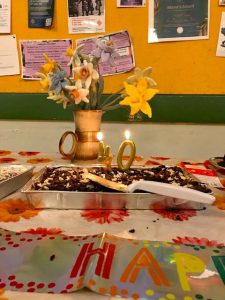 9th February 2025: Sunday afternoon members’ gala – it was apt that 40 members attended when we were celebrating the 40th anniversary of the Society.
9th February 2025: Sunday afternoon members’ gala – it was apt that 40 members attended when we were celebrating the 40th anniversary of the Society.
Peter Powis showed us an interesting selection of photographs of “Stroud and Stroudies” that he has collected and digitised – and added colour to some, which brings them to life. They were mainly from the first half of the 1900s, which included: workers at Waller engineering and Holloway ready-to-wear clothing factories; Stroud Show processions and Stratford Park swimming pool; dancing the streets in Stroud at the end of WW2. A few were later – the police station and Merrywalks shopping centre as it was.
Pauline Stevens launched her new book “Ebley – Cider Factories, Inns, Laundries, an Orphanage and an Anglo-French Ladies College“.
There was a pub quiz, sandwiches and cake, second-hand local books for sale and a display about The Shambles to look at. So it was a full and sociable members’ afternoon.
2024 meetings & visits
8th December 2024: Ripping yarns & wizard wheezes – the golden age of British comics, 1950-75 by John Reid
This was a memory jogger. We were reminded of the reading matter of our childhood, when comics were abundant – at one time there were 45 to choose from. After their rise in popularity, they declined as other forms of entertainment became more available, such as TV, and there were other things to spend pocket money on. John brought some examples of various comics along – some for boys, others for girls and some seen as “more suitable” than others. One of the famous cartoonists was Leo Baxendale, creator of many of the Beano characters, who came to live in Eastcombe. The Beano is one of the few comics that are still available today.
14th November 2024: ‘Bisley’s Edwardian Photographer, Frederick Major’ by Howard Beard
After a very short AGM, Howard showed us some wonderful old photographs. They were the work of Frederick Major, who was born in Lechlade, one of 12 children. In his late teens he worked as a footman in London, so he must have been quite tall, but later he came to Bisley where he became a gardener and a photographer. This was in the early years of the 20thC, when few people owned cameras. He produced postcards, which Howard explained were sometimes actual photos, sometimes pixellated prints. The former were much clearer. Most of the pictures had people, particularly children, included – that way he sold the postcards to the families of those in the picture and made more money. Many of the photos were of Bisley, but also the surrounding villages and of Stroud. We saw quite a lot of bicycles and horses, but only one car. Farming scenes were very interesting – hard work and lots of workers, as were the pictures of Bisley in the snow in 1916. Farming practices, prams, clothing styles, road surfaces and the digging of snow by hand told us a lot about the social history of that time. (I did not see any big brothers pushing or carrying younger siblings, only big sisters, but maybe they had to shovel the snow!)
17th October 2024: Rare films of Woodchester Convent and Roman Pavement
In the past year SLHS was given two short films made locally. Rarely seen, we saw these, as well as a set of still photographs of the real Woodchester Roman mosaic taken in 1973.
Woodchester Convent – Thanks to Jenny Bailey, who produced the DVD, our first film took us on a tour of the convent, indoors and out.
Tricia Dunbar of Woodchester Historical Society gave us a copy of the booklet she has written using the convent’s own archive. The Poor Clares – an enclosed order – originated in Belgium in the early 17th century. The convent at Woodchester was established in Summerwells House in 1860, with enough land for growing vegetables and chickens. An orphanage was built there and the sisters also started a small primary school attended by village children as well as the orphans. Later they ran literacy classes for local girls and young women, some of whom were employed in a laundry and, later, in sewing workshops on site making shirts for Holloways and other wholesalers. These workshops employed 30 to 40 local women and later they made overcoats and suits for the Holloway branch in South Africa. As their numbers reduced, the orphanage and laundry were closed and the remaining sisters’ income came from making and selling altar breads. From an original community of 30 sisters, only five remained in 2010 and the sisterhood moved out, first to a Poor Clare community in Devon then to Arundel.
It was used for a short-lived boutique hotel and a music venue, but the Grade II listed convent building is at present boarded up.
Woodchester Roman Pavement
The second film was made by Cliff Smith when the Roman pavement was uncovered in 1973. This was the last time the real mosaic was seen and two local builders – Bob and John Woodward – decided to make a full-sized replica.
The mosaic – made in 325AD – was part of a Roman villa and was known of in 1693. It was excavated in 1793 by local antiquarian Samuel Lysons. His beautifully illustrated book about his discovery of the 64-room villa is in the collection of the Museum in the Park.
This fascinating film shows the pavement being uncovered, viewed and re-covered for what became the final time. Many volunteers were involved, schools visited the site and special buses were put on from Stroud for visitors to see the second largest known mosaic in Northern Europe.
We were told that although the replica was sold and destined for Italy, it still remains in this country in a warehouse. Woodchester Parish Council has tried repeatedly to buy it, so far without success.
19th September 2024: Visit to Days Cottage Orchard
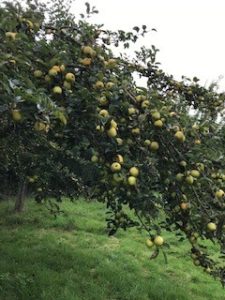 Members of the Stroud Local History Society visited Days Cottage Orchard in Upton Lane, Brookthorpe, for what transpired to be a most fascinating and informative morning. We were warmly welcomed by the owners, Dave and Helen, who have been custodians for over 30 years. The orchards have been in Helen‘s family for a very long time. Indeed, we were shown trees that were planted by her great-aunt over a hundred years ago – still healthy and flourishing. Dave and Helen quit their professional jobs in London when the opportunity came to take over the orchards, thinking that they could continue their professions locally, on a part time basis. However, it soon became apparent that the orchards would need all of their time and attention, so that they needed to dedicate six full-on days a week to this cause. Their enthusiasm is infectious. They are passionate about preserving the rich heritage of Gloucestershire‘s apples (over 200 varieties of both eating and cider apples), plus many varieties of pears and also plums.
Members of the Stroud Local History Society visited Days Cottage Orchard in Upton Lane, Brookthorpe, for what transpired to be a most fascinating and informative morning. We were warmly welcomed by the owners, Dave and Helen, who have been custodians for over 30 years. The orchards have been in Helen‘s family for a very long time. Indeed, we were shown trees that were planted by her great-aunt over a hundred years ago – still healthy and flourishing. Dave and Helen quit their professional jobs in London when the opportunity came to take over the orchards, thinking that they could continue their professions locally, on a part time basis. However, it soon became apparent that the orchards would need all of their time and attention, so that they needed to dedicate six full-on days a week to this cause. Their enthusiasm is infectious. They are passionate about preserving the rich heritage of Gloucestershire‘s apples (over 200 varieties of both eating and cider apples), plus many varieties of pears and also plums.
We enjoyed delicious homemade apple cake topped with quince jelly, and apple juice that was freshly pressed that morning. Then we were taken around the converted farm buildings, where the intriguing chopping, pressing, bottling and fermenting take place, before we were given samples of various drinks, from perry to cider. Delicious! Dave demonstrated a wonderful Victorian gadget to us. It peeled and sliced apples of any shape and size, just by the turn of a handle. Why aren‘t they still manufactured? It was a most enjoyable and educational visit.
17th August 2024: A guided walk around Minchinhampton by Gary from Minchinhampton Local History Group
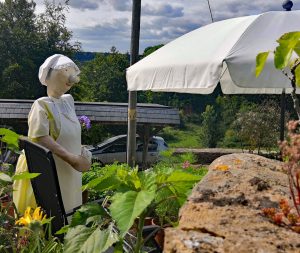 A group of us met in Bell Lane, Minchinhampton, to begin a guided walk of the town. Gary gave us an interesting tour and was very mindful of our safety when we strayed off the pavements! As we walked, it quickly became apparent that in the past Minch was very well served with pubs and inns, many of which are now private houses. Also, it used to have a wide variety of shops; two butchers, greengrocers, a sweet shop and many others – far less today.
A group of us met in Bell Lane, Minchinhampton, to begin a guided walk of the town. Gary gave us an interesting tour and was very mindful of our safety when we strayed off the pavements! As we walked, it quickly became apparent that in the past Minch was very well served with pubs and inns, many of which are now private houses. Also, it used to have a wide variety of shops; two butchers, greengrocers, a sweet shop and many others – far less today.
We were able to go in and look inside the market house. It dates back to the 17th century and the hall upstairs is used for all kinds of functions. On the stairs is an old information board proclaiming the prices charged by the early fire brigade, with the need to make an official “call” to them – not a speedy process for them to turn out it seems. (The fire station used to be here.)
As we looked at some of the old buildings on Well Hill we were joined by a group of cows, who were on their way back to the common, leaving a few calling cards as they passed. In King Street we were told that some of the American servicemen who were stationed on the common during the war made regular visits to some of the weavers’ cottages here. To our left was an impressive view across the valley, including an eco-house with a green roof, and then we entered Nun’s walk. This is an alley which was built to funnel the mill workers from their homes in Minch, including Ricardo’s terrace, to the mills in the valley. It has tall walls, which would have protected the walkers from the elements, but primarily the walls were to protect those who lived in Lammas House from the unsightliness of the lower orders.
A final visit to the church, where the organ is being repaired – this has resulted in revealing a memorial to a baby girl, which has been hidden for many years. This should be moved in the near future.
19th June 2024: More stories from the book “Stroud’s Imperial Hotel and its neighbours” by Pauline Stevens.
This talk took place at the Stroud Hotel, in the function room where the Imperial Hotel’s original stables and coach house stood. The focus of the talk was on people that have a story in the book – Elizabeth Matthews and how the convent at Beeches Green was built; innkeepers of the Railway Hotel (now Sorrento); occupants of 8 Rowcroft – now Fireside Bookshop; Lord John Russell; Frances Lawson hotel keeper at the Imperial Hotel for over 50 years.
21st May 2024: A walk entitled ‘Footprints and Footpaths rather than Footnotes’ by Stuart Butler.
We started at Stroud railway station and walked through town to The Castle, then down past Waitrose to the canal and along the towpath to Wallbridge. At suitable places we stopped for an observation or a story – about Stuart’s family, railways, local, national and international events – and had contributions from the audience. We had an interesting two hour walk and pondered about: why don’t people whistle anymore?
18th April 2024: Cider Making in Gloucestershire – from foxwhelps to firkins!’ by Andy Meller
What a good speaker! We heard such a lot about cider, a rural drink that became fashionable in the 1600s, when French wine imports were banned. Bottles that could withstand sparkling drinks were developed in Gloucestershire. For many years some workers were part paid in cider. The acreage of cider orchards in the county is much diminished, but small brewers are now flourishing and developing specialist orchards of heritage varieties.
21st March 2024: From Horse-power to Motor-power
Elizabeth Wright presented a slide-show of pictures from the Howard Beard Collection. This well chosen selection depicted different modes of transport in the Stroud district in the decades around 1900, with some unusual items. A member recognised a famiy member in a wheelbarrow!
11th February 2024 Sunday afternoon members’ gala – Cotswold Arts and Crafts and Folk Music – A presentation by Martin and Sian Graebe.
As well as a talk about the lives of people involved in the arts and crafts movement in our area, we were entertained with music and songs. This was followed by afternoon tea and chat, so was a very social occasion.
2023 meetings & visits
10th December 2023 (Sunday) Members’ afternoon 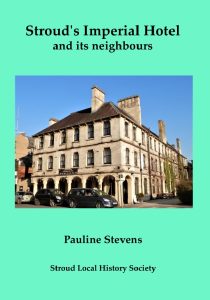
Pauline Stevens showed some of the pictures from her new book “The Imperial Hotel and its neighbours”. We saw how the Imperial Hotel has been extended from its original plan and the buildings that used to be in Station Road. She then told the dramatic stories of what happened to the two houses that once stood where Stroud House is.
After refreshments, we started our new members project of “Stroud in the 1970s” with chatter about memories of the area at that time.
16th November 2023: Howard Beard’s “More Favourite Photographs from the Stroud Valleys” – a Second Selection
After a short AGM, the speaker for the evening was Howard Beard, who is well-known for his books and postcard collection. Howard’s book “Favourite Photographs from the Stroud Valleys” was published earlier this year by SLHS. Choosing 189 images for it from his archive of almost 20 000 was a difficult task. This slideshow contained some of the pictures that didn’t quite make the book.
First he told us how he started collecting, many years ago, and the variety of things he has – including grandfather clocks. As always he showed lots of interesting pictures from his extensive collection, each with an anecdote. Some had a family connection, other stories came from his research – all without notes. It was a very enjoyable evening.
19th October 2023: Looking Back by Steve Marshfield. Steve has been taking photographs in and around Stroud for many years, both for himself and the local council. As well as aerial photos, we saw inside some mill buildings and the mansion at Stratford Park before it became the museum. We saw the High Street and Union Street in the days before Cornhill market place was built. It brought back many memories of Stroud Past.
21st September 2023: The Stonemasons’ Guild of St. Stephen based at Woodchester Mansion. Master Stonemason Steven L’Normand captivated the audience with the history, traditions, culture and continuity of his ancient craft. After his five-year apprenticeship in the City of London he spent two years as a journeyman – which means going on a journey, on foot (apart from ferries), looking for work. Steven travelled around France, Belgium, Italy and Africa, learning and practising his craft. He has worked at the Tower of London, Versailles and in the Doges Palace in Venice; the piece he is most proud of is in the Vatican. Steven now teaches at Woodchester Mansion, which is an ideal and unique building to train stone masons.
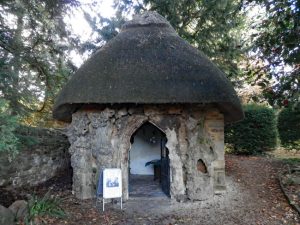 July 25th 2023: Visit to Dr Jenner’s House Berkeley. It was very appropriate time to visit the home of Dr Jenner and the story of vaccination. As well as his pioneering scientific research, Jenner also made observations of birds and mammals and experimented with hot air balloons.
July 25th 2023: Visit to Dr Jenner’s House Berkeley. It was very appropriate time to visit the home of Dr Jenner and the story of vaccination. As well as his pioneering scientific research, Jenner also made observations of birds and mammals and experimented with hot air balloons.
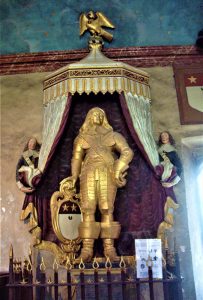 May 11th 2023: Lydiard Park –near Swindon. Rob Burles told us the history of Lydiard Tregoze, which was mentioned in the Doomsday book. We heard about the families who lived there and the small church, which has such a lot to see inside. There are extraordinary medieval wall paintings and monuments, including two memorials by Stroud sculptor Samuel Baldwin in the 1600s and a golden cavalier. Then in June we visited Lydiard Park for a guided tour of the small but fascinating church.
May 11th 2023: Lydiard Park –near Swindon. Rob Burles told us the history of Lydiard Tregoze, which was mentioned in the Doomsday book. We heard about the families who lived there and the small church, which has such a lot to see inside. There are extraordinary medieval wall paintings and monuments, including two memorials by Stroud sculptor Samuel Baldwin in the 1600s and a golden cavalier. Then in June we visited Lydiard Park for a guided tour of the small but fascinating church.
April 20th 2023: Major General Sir Fabian Ware, “A truly great Gloucestershire man” by Maureen Anderson
Fabian Ware (1869-1949) was born in Bristol, which was in Gloucestershire at the time, and ended his days in Amberley. He was too old to serve in WW1 so joined the Red Cross ambulance service. Soldiers were worried that their families would not know where they were if they “fell”, so he started recording the graves of soldiers from the Empire as well as Britain. He was transferred to the army to set up and run the Graves Registration Commission, which set up memorials and cemeteries. Later this became the Commonwealth War Graves Commission. During this well researched talk we heared a recording of a speech by Fabian Ware.
March 16th 2023: W H Davies (1873-1940) the Super-Tramp Poet by John Roberts
Many people will know these opening lines from a poem by W H Davies – “What is this life if full of care we have no time to stand and stare” – one of his 800 poems. Davies was born in Newport in 1873; trained as a picture framer; went to USA as a teenager and lived as a hobo / tramp riding trains and working intermittently on farms. After losing a leg he returned to UK; tramped around to save money while writing poetry; after several attempts he achieved recognition and prosperity to become the best-selling poet of his day. He spent his last years in Nailsworth and his last home was Glendower at Watledge. What an unusual life he had – with the determination to be a poet he even gave up the chance to stay on a farm and take it over.
February 19th 2023: The Digital Stroud website was launched twenty years ago as the result of a collaborative project including Stroud Museum, Stroud College and Gloucestershire Archives. John Loosley and Marion Hearfield told us the inside story of the project that taught computer skills and collected information to produce a local history website for Stroud. Stroud Local History Society were asked to take over the hosting and have made it suitable for smartphone technology.
2022 meetings & visits
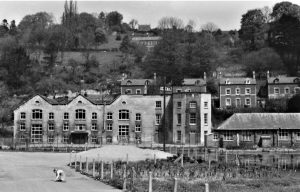 December 4th 2022: Stroud’s Lost Buildings
December 4th 2022: Stroud’s Lost Buildings
Pauline and Dave Stevens took us on a tour of the outskirts of the town to see buildings that have disappeared, using photographs taken by the late Lionel Walrond. They had been to the sites and showed us photographs of what is there now – and had some stories to tell.
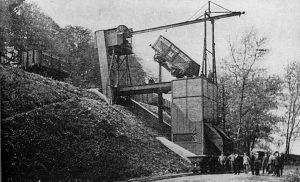 November 17th 2022: The Gasworks Tramway
November 17th 2022: The Gasworks Tramway
Mike Smith gave us a good explanation of how coal arriving on the LMS railway from Dudbridge to Stroud (now the cycle track) was transported to the gasworks. This was built by the canal, as that was how the coal was delivered originally. The railway was at a much higher level, so the coal had to go down a steep drop and over two branches of the river Frome on a tramway.
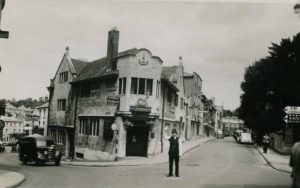 October 20th 2022: A Potted History of Gloucestershire Constabulary
October 20th 2022: A Potted History of Gloucestershire Constabulary
Sue Webb gave us an interesting talk about the history of our local police. Our county was the first to set up a rural police force, following the 1839 Act of Parliament that enabled county police forces to be formed. The Gloucestershire Constabulary Archives has a huge amount of information and Sue has done a lot of research. In the early days the policemen had no days off or holidays and police wives were expected to be at the station if the sergeant was out.
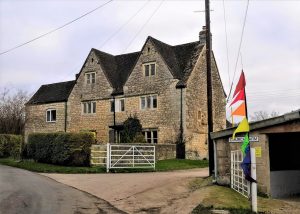 October 4th 2022: Godsell’s Cheese, Leonard Stanley
October 4th 2022: Godsell’s Cheese, Leonard Stanley
We had a fascinating afternoon in the farmhouse, where we heard about the farmhouse and farm, stories about predecessors who breed fancy chickens and rabbits for shows, as well as cheese making and tasting.
August 23rd 2022: Return visit to Thornbury
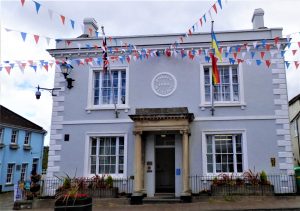
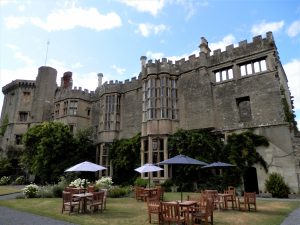 This time we were guided around the town to the church and castle by a knowledgeable guide from the Thornbury Museum, who took us into some interesting old buildings.
This time we were guided around the town to the church and castle by a knowledgeable guide from the Thornbury Museum, who took us into some interesting old buildings.
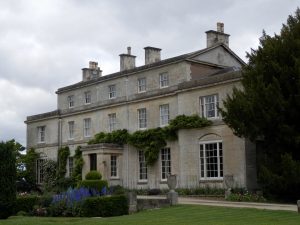 3rd August 2022: Hardwicke Court visit
3rd August 2022: Hardwicke Court visit
We had a delightful afternoon visiting this family home, which has some furniture from when the house was built – for ancestors of the current owners. It is unusual to be shown round a house by the owner, who explained who was who in the portraits. There is a garden and arboretum to explore, then we moved to the Fromebridge Mill for tea and chat.
26th July 2022: Thornbury self-guided heritage walk.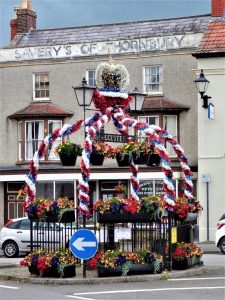
We had such a good time exploring this well-kept, flower bedecked town
that we decided to return again in August to see some more.
16th June 2022: Gloucester Southgate Street and Blackfriars
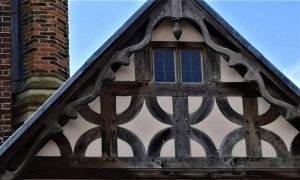
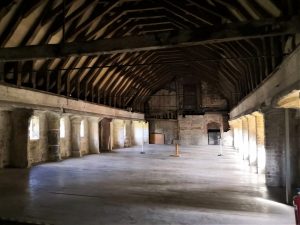 First, we had Civic Trust guides to take us down Southgate Street and into St Mary de Crypt church. They told lots of tales and pointed things out that we had not noticed before – like the nod to milkmaids’ wooden yokes on Robert Raikes house.
First, we had Civic Trust guides to take us down Southgate Street and into St Mary de Crypt church. They told lots of tales and pointed things out that we had not noticed before – like the nod to milkmaids’ wooden yokes on Robert Raikes house.
Then we had a guided tour around the huge Blackfriars Priory, with a peek into the Scriptorium where the monks used to write and study – it is the oldest surviving purpose-built library in the country.
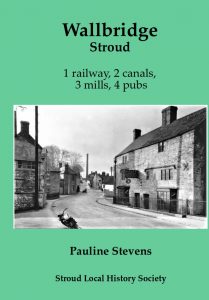 2nd June 2022: Garden Party and Wallbridge book launch
2nd June 2022: Garden Party and Wallbridge book launch
Plenty of tea and cake was had in a member’s garden on a sunny afternoon, to celebrate the launch of SLHS’s new book about Wallbridge. It was especially enjoyed by those who had not been out much and there was lots of chatter amongst friends, old and new.
4th May 2022: A walk around Chipping Sodbury
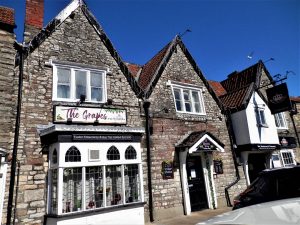 This market town was founded in the 12th century and has over 120 listed buildings. We used the Chipping Sodbury Heritage Trail to guide us around this interesting town and had tea and cake at an old coaching inn. Apart from the cars, you can imagine ladies in long dresses and men in top hats arriving in their carriages, with market traders in the wide market place.
This market town was founded in the 12th century and has over 120 listed buildings. We used the Chipping Sodbury Heritage Trail to guide us around this interesting town and had tea and cake at an old coaching inn. Apart from the cars, you can imagine ladies in long dresses and men in top hats arriving in their carriages, with market traders in the wide market place.
3rd April 2022: Visit to the Corinium Museum, Cirencester
We enjoyed this well laid out and informative museum, with Roman mosaics and many other artefacts.
Zoom Talks January to April 2022
Stroud Gasworks Tramway; Memories of Ruscombe and Randwick; Stroud’s Georgian Theatres; 1911 Pageant of Progress; The BBC At War; Community Spirit in the Stroud Valleys over the past 100 years; Stroud’s Granges – Upper Lower and West; A pictorial tour of the waterways and mills of Stonehouse; The Story of Redlers; The Knee family of Wallbridge; Ebley laundry and Ebley Cider Factory
2021 meetings & visits
Zoom Talks: November to December 2021
The Butt family – from coal merchants to builders’ merchant; Mr Sims and his Clock Tower – the Four Clocks; Howard’s family history
12th October 2021 Visit to Brimscombe Port
We had an interesting short walk, starting by the Canal Trust Bookshop then following the route of the canal into the Port – now filled in, but may be restore one day. Our guide was Philip Baker who had prepared laminated handouts of pictures for each of us and showed us how to compare “now” with “then”. After seeing where the Thames & Severn Canal Company Headquarters once stood, we returned to the Ship Inn for refreshments and chat.
8th September 2021 Visit to Matara Gardens, Kingscote
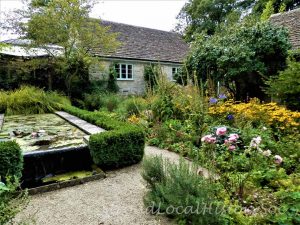 We had a delightful afternoon looking around the series of different gardens with lots of things to look at. There are 28 acres, ranging in style from the oriental to wild flower meadows and Monet. Kingscote Park was still owned by the Kingscote family in 1915, and had been since the 12th century. Thirty years ago, this was a stud farm, which the owner has transformed into a lovely place for weddings, events, holidays and retreats. The current house started as a farmhouse, but was enlarged in the 1790s and again in the mid-1800s to be the dower house – as a bonus, we were invited to see inside. The weather was great – sunlight dappled through the trees and by the time we arrived at Hunters Hall for tea and cake, it had clouded over but was still warm – just right for sitting in the garden and chatting
We had a delightful afternoon looking around the series of different gardens with lots of things to look at. There are 28 acres, ranging in style from the oriental to wild flower meadows and Monet. Kingscote Park was still owned by the Kingscote family in 1915, and had been since the 12th century. Thirty years ago, this was a stud farm, which the owner has transformed into a lovely place for weddings, events, holidays and retreats. The current house started as a farmhouse, but was enlarged in the 1790s and again in the mid-1800s to be the dower house – as a bonus, we were invited to see inside. The weather was great – sunlight dappled through the trees and by the time we arrived at Hunters Hall for tea and cake, it had clouded over but was still warm – just right for sitting in the garden and chatting
24th June 2021 Visit to Frampton Manor Gardens
This was the first opportunity to meet up with members for ages, which was much appreciated. Our guides were the owners themselves and we are very grateful for their stories, their explanations, and three kinds of cake. What more could we ask? The estate buildings evolved over several centuries, with tiny clues for dates and plenty of circumstantial evidence, described with enthusiasm. The gardens were started by Rollo Clifford’s mother just after WW2 and later taken over by his wife Janie. The result is relaxed profusion and beautiful plants – a lemon tree and fig illustrate the mildness of the garden. We were able to look in the very old wool barn too.
2020 meetings & visits
19th November 2020 Illustrated Talk on Callowell House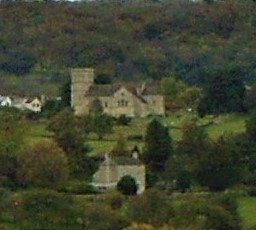 – on Zoom
– on Zoom
Pauline Stevens had received an enquiry about the previous owners and occupiers of Callowell House. This was in preparation for a proposed programme in the television series Old House, New House. Pauline showed us the results of the extensive research she has done, mainly from online sources – this research began with sorting out which of three Callowell Houses in the area was the one in question! This was Upper Callowell House which was built by 1827. The owner then was William Hogg whose son later owned Uplands House.
She described the occupiers over the years, and showed the large number of detailed and interesting house sale notices from the early 20thC. From the 1920s the house was lived in by the Withey family, long-time owners of a High Street grocers shop, and now owners of James and Owen, the Stroud stationers.
9th February 2020 An afternoon with a Country Auctioneer
We had a very entertaining afternoon with Philip Taubenheim, managing director of Wotton Auction Rooms. His father was a book dealer, and when he thought Philip should be thinking of his future career, sat him down with the Yellow Pages, from which he chose Auctioneer. This ideal job for him led after a short time to Wotton-under-Edge, where he has enjoyed much success since. He told us many stories about his experiences, and explained how auctions have changed completely since it became possible to bid remotely; he has been alone in an empty room conducting an auction whose only bidders are online or on the telephone…. After a short break for tea, sandwiches and cakes, Philip examined and described each of the many items the audience had brought in, giving a rough valuation, and telling yet more amusing anecdotes prompted by the items.
2019 meetings & visits
8th December 2019 Around Stroud with Obadiah
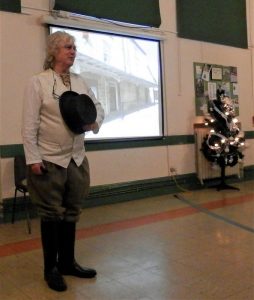 The Church Hall was festively decked out with a Christmas Tree and an immaculately dressed barman dispensing hot punch got us all in the mood for entertainment. Steve Hill from Stroud Museum in the Park, in the persona of Obadiah Dredge from the early nineteenth century, took us on a tour round the upper end of the High Street, with photographs and anecdotes of the various places (an emphasis on pubs!) and got us taking part in his songs and verses. But first he congratulated the Society on the 35th anniversary of its founding, and Marion had baked an enormous birthday cake. A short quiz devised by Pauline followed, with local place-names being examined for any remote connection to Christmas – Bisleigh? – Merrywalks? Then we had a splendid tea with home-made bites, and ended with the raffle. A good time was had by all on a cold, wet and windy afternoon.
The Church Hall was festively decked out with a Christmas Tree and an immaculately dressed barman dispensing hot punch got us all in the mood for entertainment. Steve Hill from Stroud Museum in the Park, in the persona of Obadiah Dredge from the early nineteenth century, took us on a tour round the upper end of the High Street, with photographs and anecdotes of the various places (an emphasis on pubs!) and got us taking part in his songs and verses. But first he congratulated the Society on the 35th anniversary of its founding, and Marion had baked an enormous birthday cake. A short quiz devised by Pauline followed, with local place-names being examined for any remote connection to Christmas – Bisleigh? – Merrywalks? Then we had a splendid tea with home-made bites, and ended with the raffle. A good time was had by all on a cold, wet and windy afternoon.
14th November 2019 Paul Smith – another of Stroud’s splendid Victorian photographers by Howard Beard.
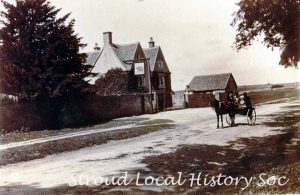 Howard took us on a tour of the area with photos from the 1880s to about 1902. They were all taken by Paul Smith, who was a member of the well-known Victorian family of artists and photographers. He worked from Stonehouse and Nailsworth but went all around the area and beyond. Howard showed us about 100 pictures and has done a lot of research to identify them; some we recognised, but others have long gone, like the enormous Vatch Mill, so these photographs are an important record.
Howard took us on a tour of the area with photos from the 1880s to about 1902. They were all taken by Paul Smith, who was a member of the well-known Victorian family of artists and photographers. He worked from Stonehouse and Nailsworth but went all around the area and beyond. Howard showed us about 100 pictures and has done a lot of research to identify them; some we recognised, but others have long gone, like the enormous Vatch Mill, so these photographs are an important record.
17th October 2019 Heavens archaeology by Neil Baker
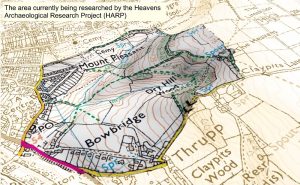 Neil leads the Heavens Archaeological Research Project (HARP) – an independent local archaeology initiative that has been investigating an area east of Stroud known locally as the ‘Heavens’. It started with Neil taking his dog for walks in the fields and grew into a thoroughly researched and documented archive. As well as discovering many old maps and deeds in the County Archives, being a landscape archaeologist, Neil has been able to access different aerial digital scanning techniques. There were once three mills on the little Lime Brook; one was Newcombe’s Mill, where the bus depot at Bowbridge now occupies the former mill pond; Neil has found the sites of two other mills upstream. Our audience of 100 (almost a record) was fascinated with his conclusions and to learn that people once lived and worked in what now appears to be only fields.
Neil leads the Heavens Archaeological Research Project (HARP) – an independent local archaeology initiative that has been investigating an area east of Stroud known locally as the ‘Heavens’. It started with Neil taking his dog for walks in the fields and grew into a thoroughly researched and documented archive. As well as discovering many old maps and deeds in the County Archives, being a landscape archaeologist, Neil has been able to access different aerial digital scanning techniques. There were once three mills on the little Lime Brook; one was Newcombe’s Mill, where the bus depot at Bowbridge now occupies the former mill pond; Neil has found the sites of two other mills upstream. Our audience of 100 (almost a record) was fascinated with his conclusions and to learn that people once lived and worked in what now appears to be only fields.
19th September 2019 Stratford Park’s History by Marion Hearfield
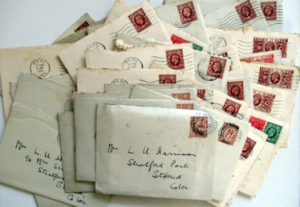 Marion described many of the sources she used to write her book about Stratford Park and the Mansion House. Several title deeds survive from the 1600s, and we had a quick lesson on how to read the ancient handwriting (‘e’s were written backwards). The 17thC gabled mansion house appears on a painting in the Museum; the house was transformed into a Georgian mansion by a Regency gent before the estate was bought by Joseph Watts, the owner of Stroud Brewery. Access to personal photographs and letters from the 1930s owners brought us up to the time when that family sold the estate to Stroud District Council; who built the open-air swimming pool, tennis courts and bowling green before WW2; added the Leisure Centre in the 1970s and the Museum in the Park in 2001.
Marion described many of the sources she used to write her book about Stratford Park and the Mansion House. Several title deeds survive from the 1600s, and we had a quick lesson on how to read the ancient handwriting (‘e’s were written backwards). The 17thC gabled mansion house appears on a painting in the Museum; the house was transformed into a Georgian mansion by a Regency gent before the estate was bought by Joseph Watts, the owner of Stroud Brewery. Access to personal photographs and letters from the 1930s owners brought us up to the time when that family sold the estate to Stroud District Council; who built the open-air swimming pool, tennis courts and bowling green before WW2; added the Leisure Centre in the 1970s and the Museum in the Park in 2001.
1st August 2019 Visit to Renishaw at Kingswood
Our visits are usually a trip to the past, but this time we had a glimpse into the future at the very modern and high-tech Renishaw, where some old mill buildings and mill pond remain on their huge site.
27th June 2019 Visit to Highnam Court Gardens and Highnam Church
We were fortunate to have lovely weather for our visit. First we were given a guided tour of some rooms in the house by the owner, and we heard how he had rescued the house and gardens – a massive renovation project. After tea and cake in the orangery, we came across many delightful wooden sculptures as we wandered in the extensive gardens, which can be seen when the gardens are open to raise money for the Pied Piper Appeal. We didn’t have time to explore everywhere as the next stop was Highnam Church with its frescos, painted by Thomas Gambier Parry when he owned the Court. There is such a lot to look at, as even the radiator covers are decorated.
9th May 2019 Visit to Leonard Stanley’s Norman Church and Saxon Barn
We were pleased to have the opportunity to visit this very old site where there was once a priory. Thanks to one of the church wardens and the farm owners we had a fascinating afternoon, with tea and delicious cake.
The first building there was a Saxon chapel, dedicated to St Swithun. The villagers used this, so, when the priory was built in the early 12th century, the monks had their own church, dedicated to St Leonard. As the number of villagers increased, more room was needed and the Norman church was shared by dividing it with a rood screen (you can still see where it was). We saw carved Norman doorways and pillar capitals, wooden stocks and ‘Old Solomon’ – a clock that rang a bell, but didn’t have a clock face. The intrepid among us climbed the narrow steps up to see the bells and the wonderful view from the top of the tower.
The priory cloisters have disappeared but there are remnants of the priory in the adjoining farm buildings. The Saxon chapel was altered in the 14th century and later became a barn, which has recently been restored but still has Saxon herringbone masonry. Under the manor house is a vaulted cellar which was once the monks’ refectory and their fish pond remains near a tithe barn.
11th April 2019 The Traditional Songs and Music of Gloucestershire
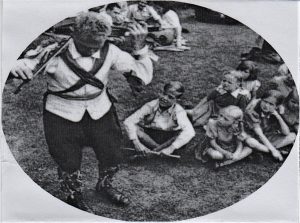 Gwilym Davies told us about folk songs collected in Gloucestershire -often songs that appear to be local have a version elsewhere. Some tunes have different words in other areas, while some songs have the same words but different tunes. The carol The Holly and the Ivy has different tunes, but the one that everyone knows came from Chipping Campden.
Gwilym Davies told us about folk songs collected in Gloucestershire -often songs that appear to be local have a version elsewhere. Some tunes have different words in other areas, while some songs have the same words but different tunes. The carol The Holly and the Ivy has different tunes, but the one that everyone knows came from Chipping Campden.
Folk songs are often about drinking, farming, love, and seafaring – even in the countryside. Some songs have local references, but many don’t.
Gwilym is one of a number of collectors of traditional songs. In the early 1900s they used pencil and paper to record ‘by ear’, or used a cylinder phonograph – the technology of the day. Now camcorders let you see the singer as well as hear them. Places to visit to find local songs included workhouses, gypsy camps and pubs. Some also collected morris dance tunes and steps.
Wassailing has been revived in Stroud in recent years, with traditional songs and morris dancing. In the early 1900s on Christmas morning, wassailers went door to door in Parliament St and Summer St, with a wassail bowl decorated with holly and mistletoe, singing carols and the Gloucestershire wassail song, collecting money, and ending in the Leopard Inn.
Traditional songs of Gloucestershire can be heard on the website www.glostrad.com
Thank you Gwilym for singing, playing and bringing us recordings.
21st March 2019 Local bus services – four decades of recollections by Chris Blick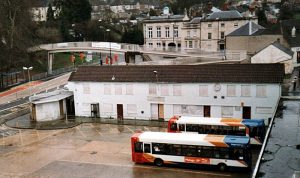
Chris gave us a fascinating illustrated talk on the history of Stroud buses and his part in that history.
The year 2019 is the centenary of the bus service in Stroud under the National banner. Chris, in his uniform jacket, first outlined the earlier days when the GWR buses ran from the railway station and National had competition from Dick Reyne in Lansdown. Chris himself joined the service in 1967. He was promoted rapidly, as Inspector finding himself travelling all over the Cotswold region, and further.
In 1983 came privatisation, and the company became the Cheltenham and Gloucester Omnibus Co. Ltd. Changes were coming with the changing demand for buses. The bus depot on London Road became a Waitrose supermarket, the buses left the bus station on Merrywalks for a time and stopped in the town once more, causing massive congestion. In 1996 all the bus staff became redundant but Chris was soon recalled and given the job of Manager. In 2003 the bus station itself was demolished for the extended shopping centre, a sad day.
Chris talked about the Carol Bus, decorated by children, which toured the Stroud district for years at Christmas, and about the special buses – with staff in costume – for the Stroud Show. He mentioned the huge overnight task decimalisation of the currency brought, his work as a magistrate, and his service providing transport for the disabled, for which he was awarded the B.E.M., one of his many awards. A few funny stories ended this absorbing talk.
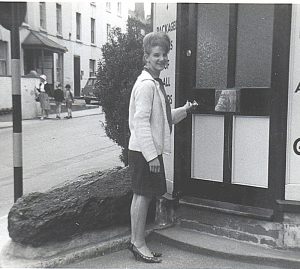 17th February 2019 A Bisley Girl with Judy Sawyer
17th February 2019 A Bisley Girl with Judy Sawyer
At our annual Gala Afternoon, Judy entertained us with an illustrated account of growing up in Bisley and of her subsequent careers. After some photographs and descriptions of Bisley life – ‘our house was SO cold!’ – she talked about working in ET Ward’s coal merchant’s offices in London Road – remember that huge lump of coal on the pavement? – and as a very successful agent for a party plan company selling Pippa Dee ladies’ and children’s clothing. She then moved on to found Sawyer’s Estate Agents, which she ran for 28 years. She was the first lady owner of an estate agent in Gloucestershire. To begin with the shop was just about big enough to house Judy’s desk and an iron spiral staircase. Sawyers is now in bigger premises in George Street – the old Post Office Inn. Judy stressed the importance of getting on with life and having a go at things, as she has.
After tea, sandwiches and home-made scones with cream and jam (much enjoyed) organised by Vesta Rock, one of our members, we had a Pub Picture Quiz – all the old pictures were recognised, but members didn’t admit to frequenting them all.
2018 meetings & visits
9th December 2018 Poetry to amuse, inform and entertain by Peter Wyton
Peter is regularly heard on Radio Gloucestershire’s Mark Cummings show, as he is the ‘Breakfast Show Bard’. His poems are observational and include history and places in Gloucestershire, and he included some about Stroud and the Beatles, and also George Holloway. As it was our ‘Christmas meeting’, we had a quiz of old pictures from Howard Beard and seasonal nibbles.
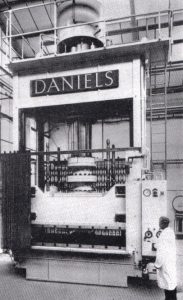 15th November 2018 T H & J Daniels, Engineers of Stroud by Ray Wilson
15th November 2018 T H & J Daniels, Engineers of Stroud by Ray Wilson
Ray gave his well researched talk to 106 of us, after our AGM. He had plenty of pictures to show us and included the products that Daniels made, which changed over the years; maps of how the site developed, and the site today; war work in WW1; some of the people who worked there; and companies associated with Daniels, which made chainsaws and fibreboard.
Daniels started as blacksmiths about 1840; made machinery for other local industries; later they made gas plant, gas engines and gas pumps; during WW1 they made the components for shells (but didn’t fill them); in the latter years the company was well known world-wide for making machinery for the plastics industry, and was one of Stroud’s largest employers.
It was a family business until 1968, then had various owners until it closed in 1988. You can still find still items made by Daniels around Stroud – at The Malthouse at Salmon Springs and Stroud railway station.
18th October 2018 Discover your house’s history by Rose Hewlett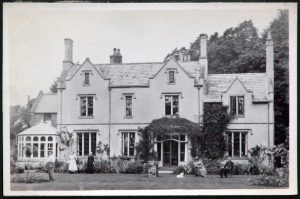
Rose gave us good examples of practical ways to find out more about the history of your own house, from deeds to old newspapers, maps, visits to Gloucestershire Archives, websites, census returns, parish magazines, sales particulars and planning applications, trade directories and local books.
New page on this website Documents and maps for research
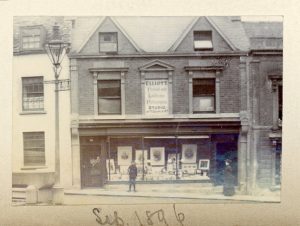 20th September 2018 Pictures of Victorian Stroud by Howard beard
20th September 2018 Pictures of Victorian Stroud by Howard beard
As the Parish Church was celebrating the 150th anniversary of its rebuild and we had a display there, we were in the church for this meeting. Howard showed us photographs by Stroud photographer John Elliott who was active in and around Stroud 1870-1902. We had a tour around Stroud’s streets, with people in beautiful detail, then out of town.
John Elliott was a Stroud photographer whose work followed that of Edmund Gibbs and preceded Henry Comley. They had in turn all occupied the same studios – first in George Street and then in Russell Street. Comley was followed by Dennis Moss and his son-in-law Edwin Peckham – whose County Studio was familiar to Stroud residents right up to the 1980s.,
19th July 2018 Visit to Lodgemore Mill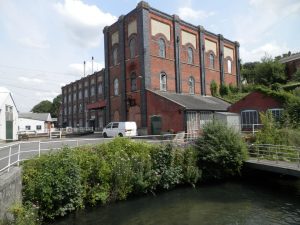
Our second linked mill visit was to WSP Textiles at Lodgemore Mill. We once more toured the working mill in small groups, and started where the woven cloth came in from Cam Mills, and seeing the process through for each of the different cloths. The billiard cloth was first painstakingly examined for any weave faults which were hand repaired, and then sent on its way for washing, milling (fulling), raising the nap, aligning the nap most precisely in one direction for billiard cloth – leaving it fluffier for tennis balls. Then came dyeing, shearing, inspection and packaging. We saw wonderful mesmeric cloth-handling machines which bunched the cloth up and straightened it out, folded it and rolled it, and we were amazed at the rainbow of colours in which both tennis ball cloth and billiard ball cloth can be produced, and at the cloth printing facilities. In the tennis ball cloth testing department we saw how the test balls are made in small batches and then subjected to heavy use. Once again we thoroughly enjoyed our tours with excellent knowledgeable guides who showed their pride in the beautiful finish of the final worldwide championship level products.
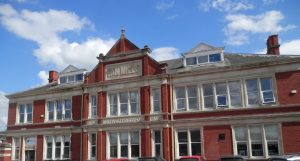 14th June 2018 Visit to Cam Mills
14th June 2018 Visit to Cam Mills
A large number of us visited Cam Mills, while they were working. This was the first of two linked visits to the factories of WSP Textiles. We were welcomed with a brief history of the site from 1522, when it was a corn mill. Then we split up into fours (so that we could be kept under control!) issued with ear plugs and high-vis jackets, and taken on a tour, from the warehouse where the bales of wool are stored, through cleaning very thoroughly, mixing the recipes of different fibres, carding, spinning and finally weaving the wool. Cloths for tennis balls and billiard cloths have different weaving patterns and we saw how the looms are set up. We ended up where the cloth is packaged ready to be transported to Lodgemore Mill. We are grateful to our many excellent guides for their fascinating informative tours
17th May 2018 Visit to Wick Court Arlingham
This is a Farm for City Children, a charity founded by children’s author Michael Morpurgo and his wife. The children who were there that week expertly guided us around the 17th century manor house and farm. We were there on a lovely sunny afternoon and enjoyed seeing the animals and buildings. It was rounded off with scrumptious tea and cake.
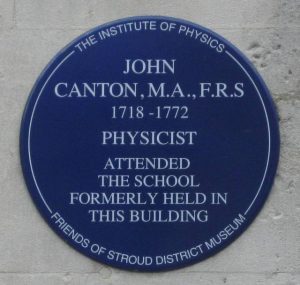 19th April 2018 John Canton – a Blue Plaque in the Shambles by Barry Harrison
19th April 2018 John Canton – a Blue Plaque in the Shambles by Barry Harrison
See the story here: John Canton famous Stroud scientist
As 2018 was the 300th anniversary of the birth of John Canton, Barry Harrison retold the story of how this Stroud weaver’s son became an outstanding mathematician and philosopher (we would say scientist). See March 2016
15th March 2018 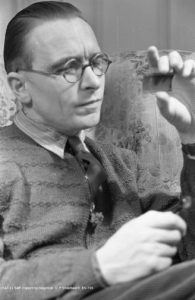 Rodney Shepheard – Stroud photographer by Marion Hearfield
Rodney Shepheard – Stroud photographer by Marion Hearfield
Another packed meeting, this time we welcomed several guests who had come to the first showing of a remarkable collection of photographs taken in the 1940s by local engineer and amateur photographer Rodney Shepheard. The story of the collection is told here
18th Feb 2018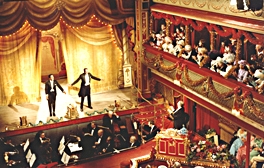 The Stars and Songs of the Old Time Music Hall.
The Stars and Songs of the Old Time Music Hall.
Members and guests who attended our annual Gala tea party in the Old Town Hall were delighted by Diana Humphrey and Fred Ward’s stories about the Old Time Music Halls. There was a lot of singing along as Diana and Fred guided us through those significant decades. One member of the audience wondered how it was that we all knew the words! and if any later generation would remember those old songs.
2017 meetings & visits
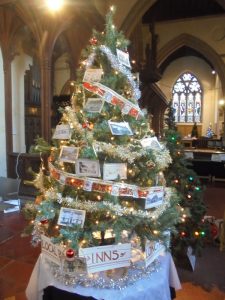 7th December: Schooldays and Christmas days in old films.
7th December: Schooldays and Christmas days in old films.
Local film-maker Alan Vaughan revived many memories of the remarkable Miss Gladys Beale of Minchinhampton (who lived to be 106) when he showed his film about her life, and the Blueboys School she started at Minchinhampton. Link to article in Cotswold Life. His second film – a wry and satirical depiction of modern Christmases – made us all laugh.
16th November: Recent Acquisitions and Research – by SLHS members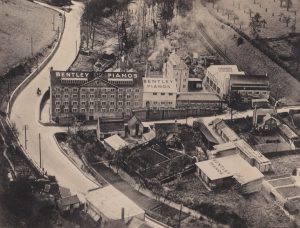
After the AGM:
- We saw pictures from our summer visits
- Howard Beard talked about his collection
- Liz Wright talked about her Badbrook research
- Marion Hearfield showed some 1940s photos from the Rodney Shepheard Collection (there will be more in March 2018)
- Pauline Stevens and Peter Powis talked about the progress of our Holloway Project
- We saw pictures of Woodchester piano works and saw mills
Also on view were some of our Holloway ledgers, our Holloway display from the summer exhibition, and some G Waller brochures.
19th October: Old Stroud Brewery
Marion Hearfield showed us pictures of the Stroud Brewery in its prime – where the Ecotricity HQ is now and the empty triangle opposite. The windows with bars that face the canal (bring repaired at the moment) were where the wines and spirits were kept securely. Stroud Brewery took over Godsells Brewery at Salmon Springs, and we saw pictures from our visit as well as Marion’s peek into the attics. Marion’s book tells the story of the Old Stroud Brewery at Wallbridge
14th September: Salmon Springs
During tea and biscuits in the Malthouse Bar, we listened to a talk about the malting process. Looking up, we could see the original tiles with holes in the floor above. In the basement we saw where malting took place, and found pillars made at TH & J Daniels and beams with the original Baltic shipping marks. Then we went outside and explored the Salmon Springs site, hearing about its many owners and uses, and a couple of rather odd stories.
20th July: Hawkwood College
18 of us had a guided tour and heard about the history of the house and estate which was originally called The Grove. The Capel family owned it for over 200 years. The house was rebuilt in the 1840s after a fire, but the stables are older. We heard about Lily Whincop, who started Hawkwood College with Margaret Bennell. Since then it has changed and developed into an educational and conference centre, with its farmland and woodland managed by partner organisations.
15th June: Bailey Paints at Griffin Mill, Thrupp
The company not only sells other companies’ paint and advises customers on all aspects of decorating – the interesting part is that they also make their own paint. As well as launching a range of domestic paints, they have a research department to meet the demand for specialist paints to be applied in unusual places and temperatures.
Old photographs and stories were on display in the room where we had tea and biscuits, then small groups of us were taken round the factory where we found out just what has to happen to get paint into a tin. Milling and grinding of pigment blocks goes on in huge rolling vats that are much older than the present owner, Richard Townsend. Blending pigments, mixing, quality testing and filling of tins all happen on site, with a surprisingly large turnover. It is a busy place.
The company was founded at Stafford Mill in the 1880s by Stanley Gordon Bailey, who had come to Stroud from south London. It was later taken on by Richard’s father and the company is now with another generation of ownership and enterprise.
18th May: Brockworth Court
We had a rare opportunity to visit this former prior’s house, which Henry VIII and Anne Boleyn visited in 1535, only a few years before Llanthony Secunda prior was dissolved. The current owners told us about restoring the house and showed us the unusual raised jetty, rare early 16th century wall paintings in the Solar room, and a priest hole. The delightful garden has a fish pond with an island, and the church next door retains Norman arches. They served tea and a lovely selection of cakes for the 31 of us in the huge restored tithe barn.
20th April: From oil mill to snow mill at Ebley
Marion Hearfield showed us pictures from our wonderful visit to Snow Business in July 2016, and we heard about the various uses that the mill has had. She even made snow into a snow ball – but did she throw it at us???
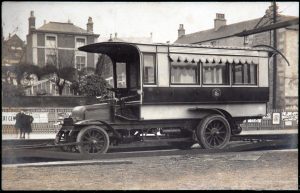 16th March: Edwardian transport in the Stroud area.
16th March: Edwardian transport in the Stroud area.
Howard Beard’s illustrated talk was both popular and entertaining. He showed us 150 pictures of transport in the Stroud area, including donkeys, a pig, traction engine, steam roller, road roller, fire engine, carriages, carts, wagons, horse and motor taxis, horse bus, motorcycles, cars, trains, railcar. Also deliveries of milk and bread, a butcher doing his rounds, collecting in the harvest and some accidents.
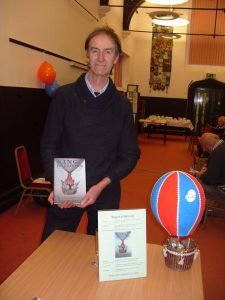 12th February: ‘Kings of all Balloons’: the first air-balloon ascents from Stroud.
12th February: ‘Kings of all Balloons’: the first air-balloon ascents from Stroud.
For our Gala Afternoon in The Old Town Hall, we had a fascinating talk by Mark Davies about the first hot air balloon flights from Stroud. Paul Hawkins Fisher, the Stroud Historian, witnessed James Sadler make the first ever balloon ascent from Stroud in 1785, and William Capel, owner of The Grove (now Hawkwood), recorded in his diary that he saw Mr Green’s ascent in 1834.
James Sadler was a pastry cook and confectioner who became the first Englishman to build and fly a hot-air balloon – in Oxford in 1784 – and the first person to cross the Bristol Channel by air. He was a man of many talents and skills and Mark Davies has written his extraordinary story. Find out more here: www.amberley-books.com/king-of-all-balloons.html.
The talk was accompanied by displays from Marion and Barry, Pauline and Marion’s model hot air balloon, then afternoon tea.
2016 meetings & visits
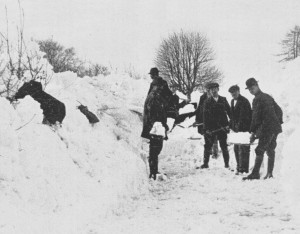 11th December: Chills and Spills – In a wintry Stroud.
11th December: Chills and Spills – In a wintry Stroud.
Marion Hearfield’s illustrated talk gave us local stories and pictures from a snowy Christmas past. She was ably assisted by Howard and Sylvia Beard (complete with accents) and Dave Stevens. The audience contributed memories and had a go at the quizzes and raffle. We also saw some old photos that we have received, as the result of enquiries via the website, and our tree from the Christmas Tree Festival was recreated. Our delightful Sunday afternoon was complete with savoury nibbles, home baking and mulled wine.
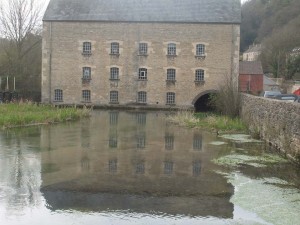 17th November: Mills In Stroud and Nailsworth.
17th November: Mills In Stroud and Nailsworth.
Ray Wilson from Gloucestershire Society for Industrial Archaeology took us on a tour of local mills, from the very small to the huge complex at Dunkirk. We heard about processes in producing cloth (surnames Walker, Tucker and Fuller all relate to fulling), and the organisation of the cloth industry; we saw pictures of various mills and how they were adapted from water power to steam power to electricity. We have a rich heritage today as a consequence of the woollen cloth industry, as fortunately many of the former mills and other buildings have been put to a wide variety of other uses. This interesting talk was very popular – 60 people came
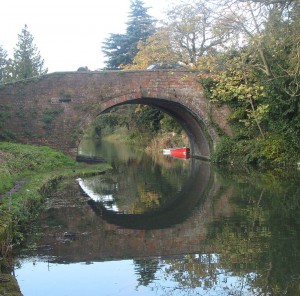 20th October: Some History of the Stroudwater Canal at Stonehouse, by Jim Dickson from Stonehouse History Group
20th October: Some History of the Stroudwater Canal at Stonehouse, by Jim Dickson from Stonehouse History Group
The canal was authorised in 1776 and by the end of 1778 it reached Ryeford, but they had spent most of the money, and had to raise more to continue to Stroud. They had to cut through the churchyard at St Cyr’s, and provide bridges, but there was no towpath until 1825 – before that men used the banks and climbed over stiles. There are several pill boxes – one is at Bond’s mill – which were part of a defensive ring around Bristol. In 2012 there were boats on the canal as part of the Jubilee celebrations.
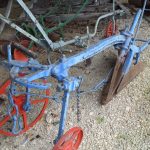
15th September: Old farm implements and old farming methods
Our September meeting took the form of a talk on farm implements by Paul Griffiths (cattle breeder and grazier on Edge Common). Paul is a true countryman, as the evening proved. Not only did he bring along two large sacks full of tools to demonstrate to us, he also displayed a group of fascinating photographs to accompany them. In addition, his talk was delightfully punctuated by poems on a rural theme, several by Frank Mansell. Along the way we learned about Paul’s early life and his many talents. He’s a stock breeder, upholsterer, cabinet maker and an enthusiastic cyclist having, in 2010, completed a ride from Barcelona to his home at Edge, to raise money for charity. Paul’s presentation was much appreciated by the audience.
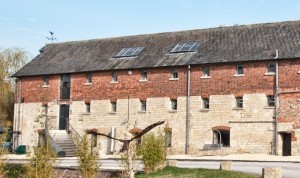 21st July: Visit to Snow Business
21st July: Visit to Snow Business
We had the privilege of visiting Snow Business at Ebley, and had a wonderful time. It is great to see a worldwide business restoring our local heritage.
Marion Hearfield presented a slide-show of the history of the oil mill – Michael Lane (SLHS member) had provide much of the information, as he is the grandson of William Lane, who was the corn mill manager. The oil mill (rape and linseed oil) was built in 1721. It was later extended and became a fulling mill in 1727, then a corn mill from 1840 to 1891. After that various businesses used different parts of the buildings.
It became the Snow Mill in 2001 and has been rescued from dereliction – the mill buildings, mill pond and grounds have been sympathetically and ecologically restored, and some of the machinery from the corn mill is still in situ. After a very interesting tour, we heard about Snow Business and some of the feature films they have provided snow for. We saw a speeded up conversion of a location from summer to winter and the clean up after – they used 7 types of snow! A wonderful evening, in spite of the rain!
16th June: Visit to Stroud Brewery
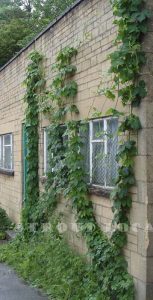 First we had a talk and slide-show from Marion Hearfield about the Old Stroud Brewery at Rowcroft. The process of brewing started at the top of the building and used gravity, with the barrels being filled on the ground floor. She has found out such a lot, and her book – written as a fund-raiser for our Society – is at the printers now.
First we had a talk and slide-show from Marion Hearfield about the Old Stroud Brewery at Rowcroft. The process of brewing started at the top of the building and used gravity, with the barrels being filled on the ground floor. She has found out such a lot, and her book – written as a fund-raiser for our Society – is at the printers now.
Then Greg Pilley told us about how he developed a hobby into the new Stroud Brewery, which has just celebrated its 10th birthday. His first brew won a prize, and later a grant + friends enabled expansion. He told us about the process of brewing and the speciality beers they now produce. We saw hops growing and casks of different sizes. A pin = 4.5 gallons; a firkin = 9 gallons; a kilderkin = 18 gallons (144 pints). A barrel is much larger, holding 36 gallons. By this time the bar was open, so some bought a souvenir to try later. What an interesting afternoon!
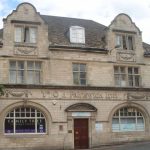
26th May: Stroud Brewery Pubs
Howard Beard showed us pictures of pubs that were owned by the (old) Stroud Brewery – ranging from Chalford, Bussage, Minchinhampton, Burleigh, Thrupp, to Stroud, Paganhill, Cainscross, Dudbridge, Stonehouse, Eastington, Frampton, Framilode, and Arlingham. Also from Painswick and Pitchcombe, to Wallbridge, Rodborough, Woodchester, Nailsworth and Leighterton. We then went further afield to Gloucester, Cheltenham and Hereford. Whilst we recognised many of the pubs, some still serve food and ale, some are now houses, but some of the buildings are long gone.
We also heard a brief history of the Old Stroud Brewery that Marion Hearfield is writing a book about – it originated in Middle Lypiatt. There were artefacts from the old Stroud Brewery to see, and photos to identify. A very interesting and well attended evening, interspersed with anecdotes from Howard.
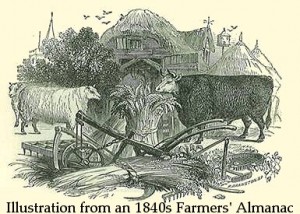 21st April: Get ‘Orf My Land – Farming development in Gloucestershire up to c1900s and its influence on society, by John Putley
21st April: Get ‘Orf My Land – Farming development in Gloucestershire up to c1900s and its influence on society, by John Putley
We started with the first farmers 6,000 years ago keeping cattle, sheep and pigs, and using antler and stone tools to grow cereal crops. In the Iron Age cattle were very important, and sheep were kept for milk and their wool (which did not need shearing). Also pigs, geese and chickens, but they grew few vegetables, although herbs were used for food and medicines. Iron tipped ploughs enabled cultivation in the vale. The Romans had farming manuals, and introduced long wool sheep here. This was the time of countryside supplying town markets. Anglo-Saxon times saw a return to self sufficiency in villages and hamlets, until Burghs were formed. Cote = sheep enclosures and wold = rolling hills. Medieval times used three field rotation, with one fallow. The Domesday Book recorded the farms. The Normans created Royal Forests for hunting, and farmed rabbits – giving us names such as Coney/Conigree and Warren. Manors were self sufficient, with open fields in strips. A consequence of Black Death in 1349 was higher wages for the fewer remaining workers. 1750 – 70 saw the Agricultural revolution – really an evolution –with new machinery and 4 field rotation with no fallow year, and Inclosure changed the field system. We ended with the Victorians applying science to farming, and increasing productivity. Transport also improved, which led a decline in farming from the 1870s due to imports.
A comprehensive and interesting talk from John
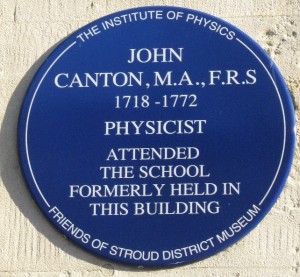 17th March: John Canton – Stroud’s First Scientist by Barry Harrison
17th March: John Canton – Stroud’s First Scientist by Barry Harrison
John Canton (1718 -1772) was a very well known natural philosopher (we would say scientist) and mathematician in his day, who has been forgotten, unlike contemporaries such as John Smeaton (Eddystone lighthouse) and John Harrison (Marine chronometer). Canton studied static electricity and lightning, luminescence, made artificial magnets, predicted lunar eclipses and proved the compressibility of water. He won the Copley Medal for outstanding scientific achievement twice and was awarded a degree from Aberdeen University. During this time he was also working as a school master.
He came from humble beginnings – the son of a weaver; born in Middle St Stroud; his schooling at the Old Town Hall (where this blue memorial now hangs) ended when he was nine. However he studied astronomy and mathematics, designed and carved a sundial, and calculated the latitude of Stroud – all before he was 17 and was taken to London.
Stroud should remember this eminent scientist. Thank you Barry for a fascinating talk.
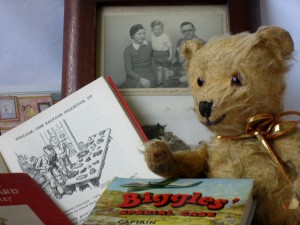 14th February,The Fighting Forties by Virginia Adsett and Gillian Morse
14th February,The Fighting Forties by Virginia Adsett and Gillian Morse
We were taken on a tour through a wonderful collection of 1940s toys, books, clothes, and everyday household bits and pieces. Virginia and Gillian’s stories about evacuees (and their little suitcases), school uniforms, comics, the Wireless, rationing, utility furniture and clothing prompted many memories. This was also a social occasion with a suitably old-fashioned Gala sit-down tea.
2015 meetings & visits
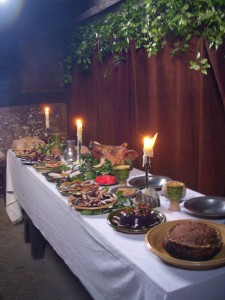 13th December: A Tudor Christmas, by Cherry Hubbard
13th December: A Tudor Christmas, by Cherry Hubbard
We had a lovely afternoon with a fascinating talk, with Tudor themed refreshments, decorations and a Tudor song. Cherry lived as a Tudor for a year, so is very knowledgeable. She brought food prepared to Tudor recipes, and talked about the ingredients they had available (oranges, but no potatoes). We heard about fasting during Advent, bread made from dried peas, and coffin pies – they did not eat the pastry case. We learned the difference between a Feast (for every guest) and a Banquet (sugary extravagances served only to the favoured few), and the origin of ‘curfew’, all to the lovely aroma of mulled wine warming on a candle.
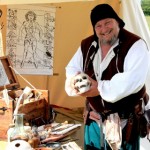 19th November: Blood & Guts and a little off the Top – Medieval & Tudor barber surgeons, by John Putley
19th November: Blood & Guts and a little off the Top – Medieval & Tudor barber surgeons, by John Putley
Our AGM was followed by a very informative talk which was both gruesome and fascinating, about medicine from the 1200s to the 1800s. In those days the physicians, apothecaries and barber/surgeons were separate professions, and the theory of illnesses was based on the imbalance of the 4 humours. Many people could not afford to pay a professional, so went to the local wise woman, who made use of the hedgerows. Urine samples aided diagnosis – the colour, smell and taste. Astrology determined treatment, and often focused on removing bodily fluids. Cures may have involved snails, walnut, clove, kidney beans, lungwort, vinegar, opium, willow bark, egg white, deer antler, mouldy cheese, coal, or tobacco for a cough! Surgery was quick – no anaesthetic.
15th October: Gloucestershire Place Names, by Anthony Poulton-Smith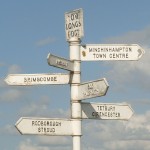
A very interesting talk about how most place names originated in Saxon times, and were descriptive. Even the use of cester for previously Roman towns was a Saxon term.
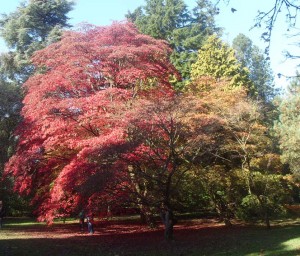 17th September: Wonders of Westonbirt & the Holford Family by Margaret Headon
17th September: Wonders of Westonbirt & the Holford Family by Margaret Headon
Margaret shared her knowledge about the historic picturesque landscape and internationally important tree and shrub collection which were collected from all over the world. Planting started in the 1850s by Robert Holford, the rich Victorian landowner to whom the Westonbirt estate belonged.
July Summer Exhibition at the Museum in the Park – click here for photographs
16th July: Chipping Campden – Court Barn Museum, talk and walk
To see photos click here
Six members met at Court Barn Museum, for a talk about Arts and Crafts, a look around the museum, and a very informative walk through the town to the Old Silk Mill craft centre.
This market town was planned in the 12th century; “Chipping” derives from the Old English cēping, “a market/market-place”. It has a layout of main street and burgage plots, and became an important centre of the wool trade.
In the early 17th century, Sir Baptist Hicks, a silk merchant, built a grand manor house (which was burned down in the Civil War), almshouses and the market hall (both still in use). The long, broad and curved terraced High Street contains many Cotswold stone buildings, built by wealthy merchants between the 14th and 17th centuries.
Due to the decline of the wool trade the population reduced. Revitalisation came in the early 20th century when C R Ashbee relocated his Guild of Handicraft, from London’s East End to the Old Silk Mill in 1902, bringing the Arts and Crafts movement to Chipping Campden. Descendants of George Hart,silversmith, still have a workshop there. This was more than art and design – use of traditional skills was important, but also a better way of life than factory work and its living conditions. F L Griggs, etcher, draughtsman and illustrator, arrived here in 1903 and was influential in preserving and restoring the heritage of the town and surrounding area.
18th June: Jet Age Museum, Staverton
The Jet Age Museum was opened specially for our evening visit and we were divided into groups of four to be taken round by volunteers. Each one specialised in one part of the museum so we had an informed and close inspection of the several different periods of aviation – pioneered or manufactured in Gloucestershire – exemplified so well in this lovely little museum. Shortly after I took this photograph of the Vulcan cockpit, Jenny and Keith were sitting in the pilot and co-pilot seats right at the top. SLHS members and their guests and were impressed by the enthusiasm and knowledge of the volunteers who run it and our visit was a great success.
14th May: Marlborough visit – The Merchants House – The House of Thomas Bayly 1653 – Guided tour
It was one of the wettest days of the summer when we had the first of our summer outings, but nothing daunted we met outside the Merchant’s House as arranged having lunched separately in various eating places beforehand. The entrance is through their well appointed gift shop from where we went upstairs to see the house which Thomas Bayly, a silk merchant, built after the disastrous fire that destroyed both sides of the High Street between 1653-70. 244 houses in total were burnt down. It is a large property of three bays and four storeys, timber-framed, with shops on the ground floor under a projecting canopy, fine diagonal chimneys above a tiled roof and leaded lights throughout in the original oak frames. Over the centuries it has been subdivided and tenanted from Thomas’ death in 1670 onwards and the shop soon became two by the insertion of a through passage. Between 1926 and 1990 it was a branch of W.H.Smith, did they have a policy of using prestigious timber-framed historic buildings in the 1920’s as the Cirencester branch is also in a similar one?
Much of the interior is original and the rest is being restored. Many of the upper rooms have walls with painted patterns, mainly bold coloured stripes; a bedchamber has vertical trailing bands of foliage in green, orange and black. These painted rooms were fashionable in c17 houses [we ran out of time on our trip to Ledbury in 2013, where the upper floor of the Town council office has some good examples.] The period furniture, pottery etc..has been acquired as per the Trust’s policy but only one of the Turkey work chairs is original, the other twelve have been commissioned. The covering of knotted wool on coarse linen is shown being worked on a tapestry frame, making a long dense pile, again in rich deep colours, and featuring tulips. It would be interesting to return once the restoration is complete, a large and costly yet very worthwhile project. Mention must be made of Howard Beard wearing a long curly Restoration wig which visitors could try on; he looked superb.
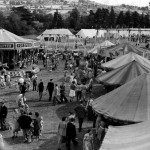
16th April: Fairgrounds – Deakins Fair by Bill Treen
Bill was born and bred, and works in Barton Street, Tewkesbury, which has been the site of the annual Mop Fair held annually on 9th & 10th of October since the 12th century. Bill could see the fair from his house, and has always been a ‘Deakin’s fan’. He has researched the Deakin Family, got to know them, and has written a book about them.
He told us about the origins of the Mop Fair for hiring workers; the Deakins Family and how the first Deakin became involved in fair grounds, with his wife carrying on the business after his early death; life on the road; their charitable work for Tewkesbury Hospital. They travelled all over the country from their base in Wales, and Bill has lots of photos, including the fair at Stroud.
26th March: The Purton Hulks – beached Severn Trows by Paul Barnett
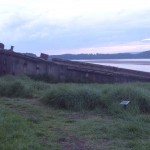
We had a talk to follow up our visit to Purton last year. Paul told us about how he became involved in researching the ships graveyard, and showed slides of some of the boats when they were still in use.
15th February: Was it really 30 years ago? Review of Stroud 1984 to 2014 by Pauline Stevens and Marion Hearfield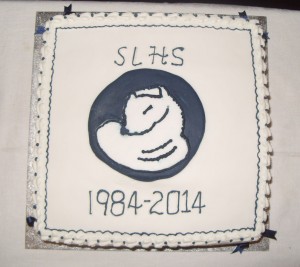
On Sunday 15th February 2015 we met at the Old Town Hall for a Gala Afternoon to celebrate the 30th anniversary of the Society. We were welcomed by the chairman, Howard Beard, and were then treated to a slide show of newspaper cuttings and photographs showing events and places in Stroud over the past 30 years. This slide show, put together by Pauline Stevens and presented by Marion Hearfield, resulted in many reminiscences and surprise at the changes to Stroud in a relatively short period of time.
To see Review of Stroud 1984 to 2014 click here
Following this, Marion described the various research projects being carried out by the Society and its members. She encouraged members to embark on local history research and report their findings to the Society. One very successful research project involved discovering the association of a J.S. Smith with Stroud. In the first World War injured soldiers were treated at the old Eastern General Hospital in Cambridge and entered messages of thanks and drawings in a recently discovered autograph book put together by a nurse. One soldier, Cadet J S Smith wrote a piece of music for a Vesper Hymn. Following a lot of investigative work by many people it was discovered that John Sidney Smith came from Stroud, survived the war and continued to be the organist of the local church for over 50 years. Addenbrooke’s choir sang an evening prayer to this music in December and we were treated to a recording made at the service.
A lovely tea had been prepared by members and a birthday cake was cut by the immediate past chairman, Sue Harrison in the presence of two former chairmen, Clive Bircher and John Loosley. During tea a photo quiz of architectural features on buildings in Stroud was displayed and members were asked to identify these buildings. It was surprising how little notice we take of the features of familiar buildings.
Howard Beard thanked all the members who had made this Gala Afternoon a great success and hoped that the Society would flourish during the next 30 years.
From Stroud to India – the Adventures of a Stroud Man by John Loosley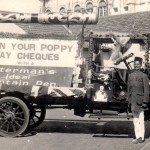
18th January 2015: We heard about a young man born in Stroud, who was apprenticed to the Stroud Journal back in 1872 and then applied for and got a job on the Ceylon Observer in 1878. He moved to Madras, India to work on the Madras Mail and then bought a printing business in Madras which he expanded into fancy goods and later into bicycles and motor cars.
2014 meetings & visits
Gala afternoon with Tea and Cakes and A Demonstration of Gadgets & Toys from the 1950s’ – Virginia Adsett & Gillian Morse
January 19th: Lots of items displayed, and remembered by many of the audience.
William Cowle and the Field Estate by Marion Hearfield
February 16th: Marion & Tony have done such a lot of research – Marion’s William Cowle website and book about W Cowle
Gloucester’s Railways – Then and Now by Tony Conder
March 20th: An interesting look at where the railways used to be in Gloucester and how the routes came to be where they are now. Who remembers the second station?
‘E P Conway – Nailsworth’s Edwardian Photographer’ by Howard Beard
April 24th : Howard admirably gave an impromptu talk, as the booked speaker unfortunately was unwell.
The Purton Hulks – wrecked Severn Trows visit
May 22nd: The Society’s visit to the Purton Hulks proved an interesting and rewarding experience.
We parked by the church at Purton and met Paul Barnett, who took us to see the ships graveyard that protects the Gloucester & Sharpness canal. We saw an empty River Severn and homes which originally housed donkeys, as well as remains of barges. Paul Barnett is both knowledgeable and dedicated to the preservation of the historically important boat graveyard. The weather stayed kind to us for nearly all the evening and, as dusk approached, Paul was thanked for a fascinating guided tour of the site.
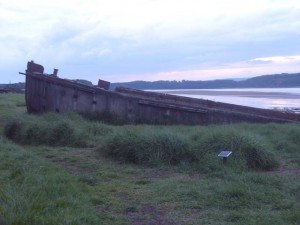
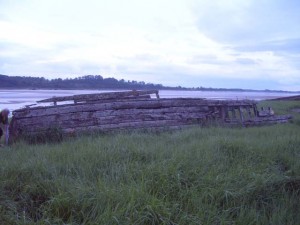
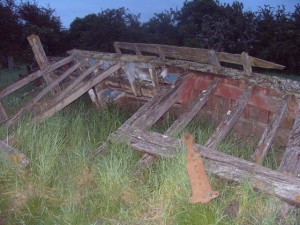
Use these links to find out more:
John Craven visits Purton Hulks – see him talking to Paul Barnett
gloucesterdocks.me.uk/canal/graveyard
Tewkesbury: Guided Tour
June 19th 2014: A small group of us were guided around the historic market town of Tewkesbury, along the main street and down the numerous narrow by-ways, by local historian Dr John Dixon, with his wife at the rear to ensure we did not get left behind and lost – certainly many places we would not have found exploring by ourselves. There was lots of history and the more modern flood protection developments to see as well.
Farm: guided tour
July 10th: Byfords Farm, Taynton
This visit was exceptionally well attended even though the local cider had not been advertised beforehand. Eric Freeman has lived in the Newent area all his life and has a collection of old farm implements, several massive dray horses, Gloucestershire cattle, sheep and pigs which are all threatened species.
Stroud and District – An A-Z in Old Postcards, a slide-show by Howard Beard
September18th: An alphabetical tour of the Stroud District illustrated from his huge collection of old photographs and postcards, many of which had never been shown in public before. There were lots of pictures of Stroud in the Edwardian era and at many different events.
‘Stand and deliver’ – Highwaymen, by John Putley – complete with disguise and guns!
October 16th: It included: how to be a highwayman; romance, myths, reality and their demise; who was Tom Long?
On our website, www.stroudlocalhistorysociety.org.uk you can read about the robbery and attempted murder of John Bird of Stonehouse in 1774 and the first regular Stroud to London stagecoach service in 1770.
‘The Man Who Took Stroud’s Temperatures’, by Barry Harrison
November 20th: Thomas Hughes was an apothecary, surgeon and man-midwife who lived in Stroud. He also meticulously recorded the weather here for nearly 40 years. His very detailed meteorological records of 200 years ago are very unusual for the time, and have been looked at again recently. We also learned about his work and connections with other professionals like Dr Jenner, and his family & life at the time. It was a very interesting talk.
Christmas Social Evening – with Magic Lantern Show – by Pat Furley
We had a very entertaining evening when Pat Furley showed original slides with an original Magic Lantern, cleverly woven into a Christmas theme. These very early slides included some interesting animation.
2013 meetings & visits
An Afternoon with an Auctioneer – Philip Taubenheim identified items brought by the audience
The Story of James and Owen of Stroud
Peter Withey talked about the history of James & Owen, the well known stationers in London Road, and the family’s long association with retail and other business in Stroud.
Springs and Water Sources in the Stroud Valleys by Stuart Butler
Stuart has collected information about local springs, and he told us about where the spring-lines are.
A Guided Tour of Fairford’s C15 Church Windows
We were met at the church by Geoff Hawkes, who gave us a fascinating guided tour of Fairford’s nationally important 15th century stained glass windows. His knowledge and expertise were evident and a most instructive evening was enjoyed by all, with many questions and expressions of admiration.
A Guided Tour of Ledbury
We had an afternoon visit to Ledbury with a guided tour around the town. Chris, our guide, met us in the town centre, outside the original St. Katherine’s hospital/chapel, early c14 in red stone, at a right angle to the Victorian hospital and alms-houses. Facing them in the middle of the car-park stands the Master’s House, [Master of the Almshouses], c15, mainly timber framed but with brick additions, currently undergoing major restoration. Owned and used by Herefordshire Council the work entails the use of large quantities of green oak. It should reopen next spring. See the Master’s House Blog for more details. At the cross-roads opposite the Market House, c17, stands the Barrett-Browning memorial institute and clock-tower, 1890’s in brick. [Elizabeth lived in the Homend as a child]. John Masefield the Poet Laureate was born in Ledbury.
Ledbury has a great many black and white buildings, the finest being Ledbury Park, c16, at the traffic lights entering the town, which was the seat of the Biddulph banking family, now apartments. They were town benefactors having endowed the cottage hospital, now converted to office/residential use. Church St. has many historic buildings. The Town Council office has wall paintings upstairs, and there are two small museums further up the street – but there was insufficient time to see inside.
The church is notable for its separate bell tower in the churchyard and the imposing Biddulph family memorial.
A Guided Tour of Gloucester Docks
A balmy sunny evening was very welcome for our July visit to Gloucester Docks where we formed two groups each with an excellent guide from Gloucester Civic Society who brought the history to life and explained the importance of Gloucester as a trading centre, later offloading sea going vessels for the canal network when this was developed.
Freemasonry in Stroud
Sharpness – a Country Dock by Ray Wilson
Lionel Hook and Sons, a local engineering company by Barry Harrison
2012 meetings & visits
Traditional song in Gloucestershire by Roy Palmer
Forty years of local history by Russell Howes
Stroud’s other industries by Ray Wilson
Frocester in old photographs by Arthur Price
A visit to Frocester Court & Tithe Barn by Arthur Price
A visit to Winchcombe Railway Museum
Historic tour of Stratford Park Mansion House by Steve Hill
Carved headstones of the Vale & Severnside churchyards by Dr Nicholas Herbert
Child employment in the Stroud Valleys by John Loosley
Stroud Workhouse by Chas Townley
2011 meetings & visits
History of Wycliffe College
A Childhood Treat – Member’s reminiscences
Humour in Edwardian Postcards
Stonehouse High Street talk & visit
The Jewish Communities of Cheltenham, Gloucester and Stroud
Cotswold Stone
2010 meetings & visits
Stroud in 1848
Illustrated by colour images on two screens, the lecture explored the building developments, living conditions and other aspects of life in Stroud in the mid-nineteenth century. The arrival of the GWR was also included. Reproductions of important local oil paintings from the collection at the Museum in the Park further enhanced a thoroughly absorbing afternoon.
Members’ Wartime Memories
The Old Town Hall looked very festive for the Gala Afternoon with tables laid and decorated with a small flower arrangement. There was a small display of wartime items from Oakridge Museum set up by John Loosley and our posters on the theme of ‘Letters Home’ and ‘Childhood in World War II in Stroud’.
Our thanks to everyone who made the afternoon such a success.
The variety of memories was extraordinary, from those of small children to teenagers and an adult playing her part in the war by decoding Japanese messages in Colombo. Some were themselves evacuees from London or the coast. One of these shared a train with exhausted soldiers who had just escaped from Dunkirk. Others received evacuees in their safer part of the country. Both told of their mystification at different life styles, including surprise at the Welsh language. We heard about the difficulty of the army and officials in getting the rural population to take dangers seriously and the use of tear gas to persuade people to understand how to use their gas masks. Speakers related their experiences of bombs, flying bombs and rockets. Some enemy action took place after the evacuees had returned home. They recalled the scary siren, which still alarms whenever it is heard, the trek to air raid shelters and the peculiar smell of bombed and abandoned buildings. One person watched from the coast as Calais burnt. Food was remembered by many including dried eggs, Spam fritters, cod liver oil and orange juice. We heard about gardens dug-up to grow vegetables, pigs in the town garden next door, the blackout, and candles and oil lamps. It wasn’t all bad. Bomb sites made good playgrounds. One speaker met Tommy Handley. Many became more self-sufficient, and people who had lived isolated lives learnt to help each other. One speaker said ‘a sense of humour saw us through’.
After those presentations everyone was ready for an excellent tea with sandwiches and cakes. They went home pleased with an afternoon well spent.
The History of Stroud General Hospital
Medicines were available in Stroud in the 18th century and Gloucester City was so impressed that they tried to follow Stroud’s example.
The Medieval Wool Trade in Gloucestershire & The Merchant of Prato (Italy)
A two part evening started with a talk about the Merchant of Prato and the woollen industry in Florence. Prato merchants looked to the Cotswolds, and especially to the monastery in Cirencester for the best wool. English wool had been used in Florence since the 11th century. This was followed by a talk about the wool trade in Gloucestershire in the Middle Ages. Monasteries were important and excellent wool was produced at Stanway and Beverstone to name just two. Northleach has a number of memorial brasses to local wool merchants who exported widely in Europe and generated considerable wealth, which they invested in local churches and some of the magnificent family houses we appreciate today.
Evening visit to the Museum Stores
17 of us had a very interesting evening and learnt about some of the issues and costs involved in conservation. As only 10% of the museum’s items are on show at the Museum in the Park, there are many thousands of items in storage. We saw fulling hammers; long clocks; statues; a Pedersen cycle; Edwin Budding’s documents for the patent of his lawn mower; an adjustable spanner invented by Edwin Budding; a collection of lace work; a 1890s wedding dress; a land yacht; an embroidery of an aerial view of Cam Mill; pub signs; tools from various local industries; and lots of boxes with small items in them!
An evening Tour of Ebley Mill
We heard about the history of the site and went inside to see some of the original fabric of the building, and where some of the water wheels were.
There was a mill on the site in the 14th century, but what we see today is Clissold’s Mill (the Long Block), and the Bodley Block (which replaced the Marling Block that collapsed after a fire). The visit ended with an opportunity to view old documents and maps of the mill site, and photos of the conversion into the present council building.
Newark Park visit
It was quite an experience to look out of the reception room window on to a vast expanse of rural Gloucestershire with the view that was more or less unchanged by the passing of 460 years since the house was built – no electricity pylons, sweeping motorway, housing estate or even prominent buildings. Newark (‘Newe Worke’ to use its original name) House is situated above wooded hillsides and parkland in the Ozleworth Valley and was built as a hunting lodge for a Tudor courtier. A large part of the stone came from nearby Kingswood Abbey which was dissolved in 1538 and demolished about 1550. In the late 1500s Newark House came into the hands of wealthy London merchants who exported Gloucestershire cloth and imported silk; they added the west portion in the 1670s. In 1769 the Clutterbucks, into cloth and banking, owned the house and modernised it around 1790. The house was then rented out from 1860 to a wealthy widow of a Bristol shipping agent whose family continued to live there until 1949 when the Clutterbuck family bequeathed it to the National Trust.
The Trust rather neglected Newark House letting it to a succession of tenants who converted it to nursing home, in which use it declined further.
It was left to an American anglophile to save Newark House. Bob Parsons saw its potential and took on the tenancy in 1970 and set about saving the property. He died there in 2000 having established a welcoming place of good food and good company. The house remains a National Trust property, and the current tenant, who had worked together with Bob Parsons, took us around and told us of the history, the decline and the redevelopment of this fascinating house.
The Early Letter Post in Gloucestershire
A description of nearly four centuries of the development of the public postal system starting in 1635. King Charles I was short of money and decided to take over the private arrangements then in place for carrying letters and create a national service. A delivery charge to various places was made, based on the number of sheets of paper used, with payment on receipt. The papers were folded with the address written on the outside and taken to the despatch office. The ‘letters’ were carried by a horse riding post-boy, mainly overnight. This could be quite dangerous for the post-boy as there were many highway robberies. It usually took three days for a letter to arrive in London from Gloucester.
Small packages and money could be sent but it was recommended that banknotes were torn in half and each half sent by a separate post to try to reduce pilferage and robbery. Banknotes were numbered in opposite corners for identification and at the time there were many banks each issuing their own banknotes.
The Mail Coach was introduced displaying the Royal Arms in 1784. It was driven by a private person but always accompanied by an official Post Office guard. Regular services between London and the main towns were established. Cross routes linking between these towns to cover the rest of the country were developed.
In 1840 Rowland Hill was instructed by Parliament to improve the system and he introduced the Penny stamp as a prepayment method, and with the same charge for the letter for delivery to anywhere in the country regardless of distance – the same basic principle still applies today. Letter boxes as collection points were introduced soon afterwards and the system developed towards the current day countrywide coverage.
The Cotswold Canals – an update
2009
Guided walk around Painswick
Twenty-three of us enjoyed a very interesting walk around Painswick on 20th May 2009. Our guides were very informative and had arranged for us to visit 2 private gardens – accessed by late 13th century donkey doors. We also had a look inside a private house which had a wonderful plasterwork ceiling.
Painswick is a town, as it was granted a market in 1253, and it was mentioned in the Doomsday Book – a priest lived here in 1086.
We saw
• National School 1846, now the library,
• Lych gate 1901– Miss Seddons wood work class carved the bells
• The yew trees planted in 1792 – 99 by legend
• The tomb stones – mostly 1750 to 1850 – flat slabs, chest or altar tombs, and pedestal or tea caddy tombs. Also a vault and a pyramid.
• Musket & cannonball damage to the church from the civil war
• Spectacle stocks – 1840
• Old public baths
• Pub signs on what are now private houses – confusing the tourists
• Roman Catholic Church – you can see where the passage to the abattoir was
• Cloth Hall 1429
• The oldest building to be used as a Post Office in England
• Town Hall 1840 (the previous one was where the war memorial is)
• A Palladian house 1760
• Falcon Hotel 1711 – a coaching inn with a bowling green, that used to have a cock pit
2009 GLHA Summer Meeting Northleach


